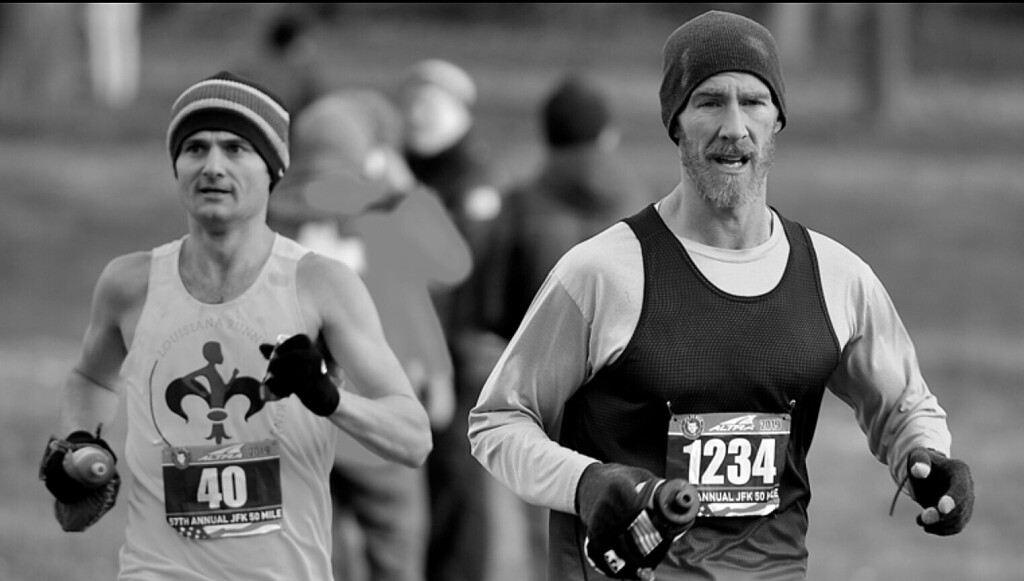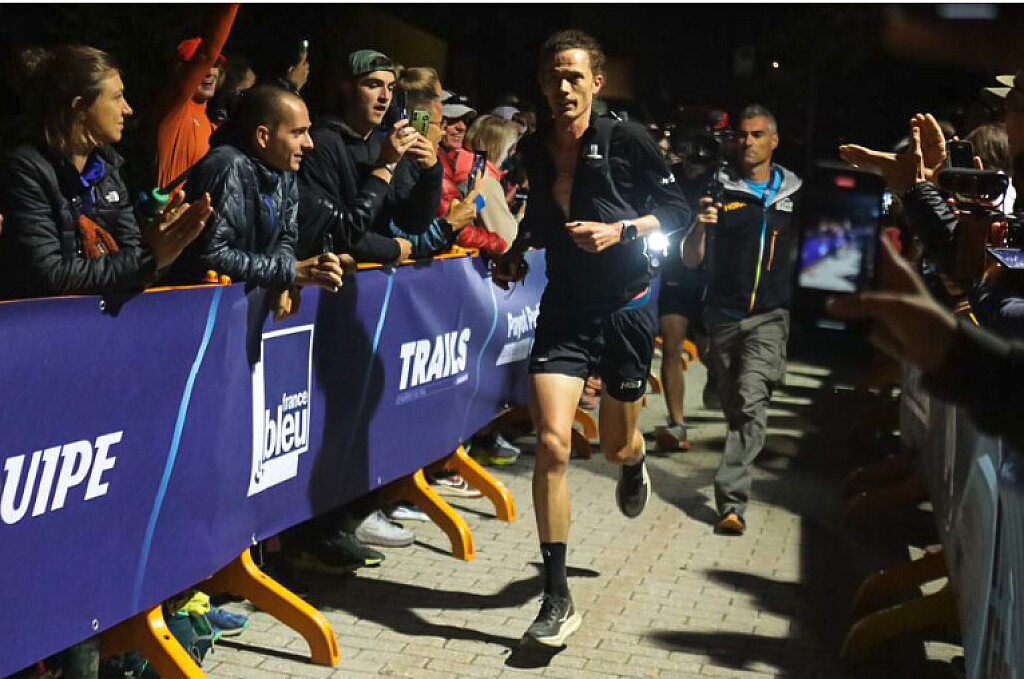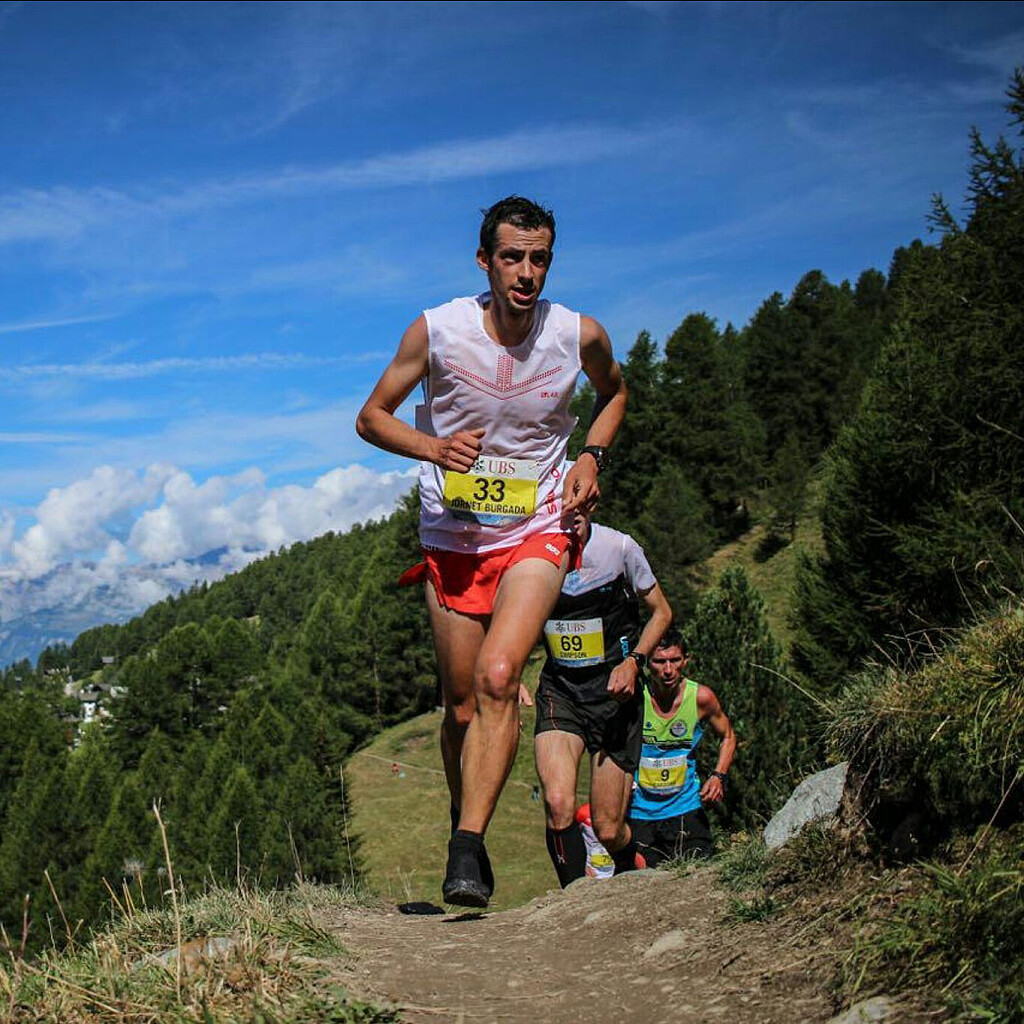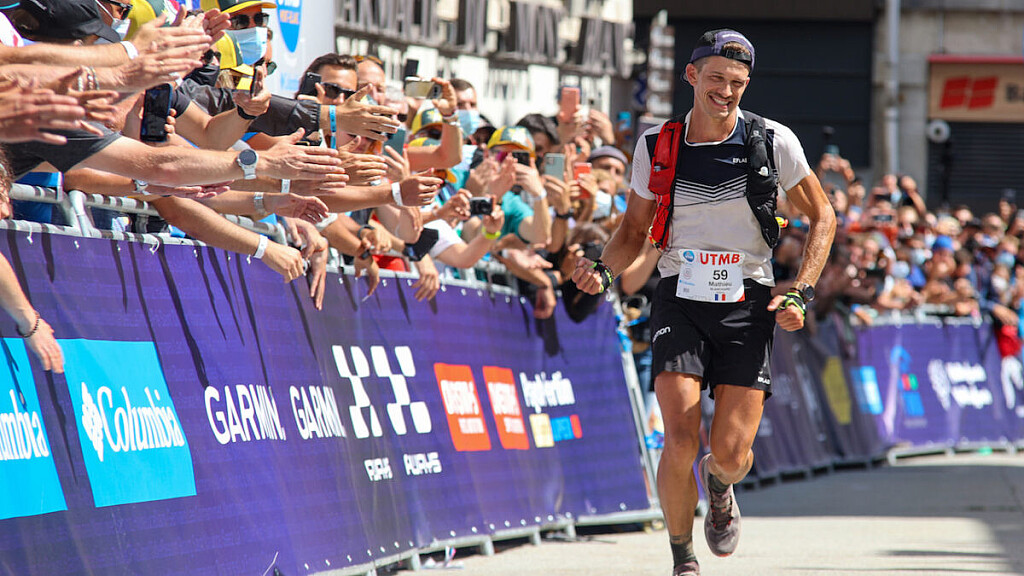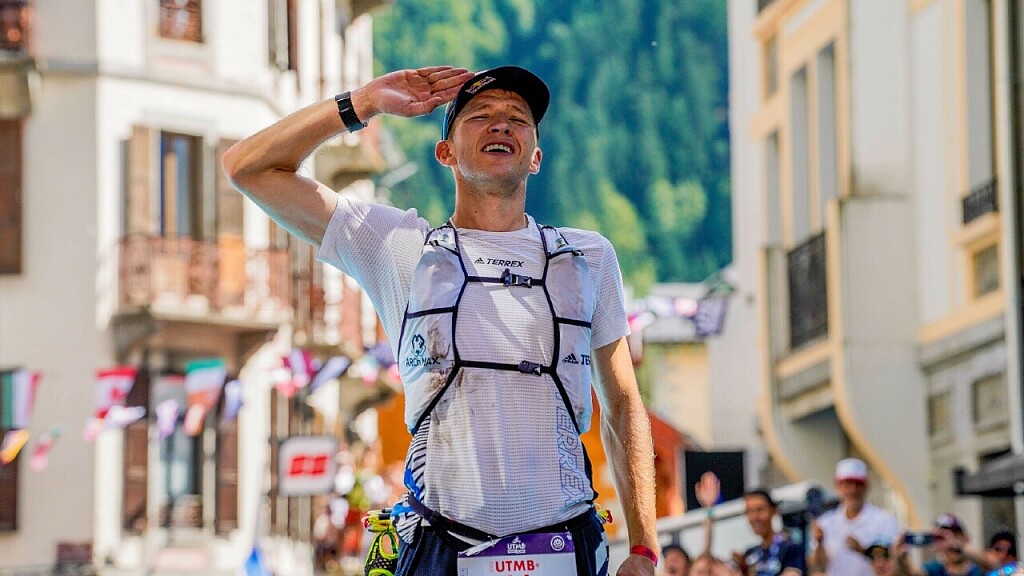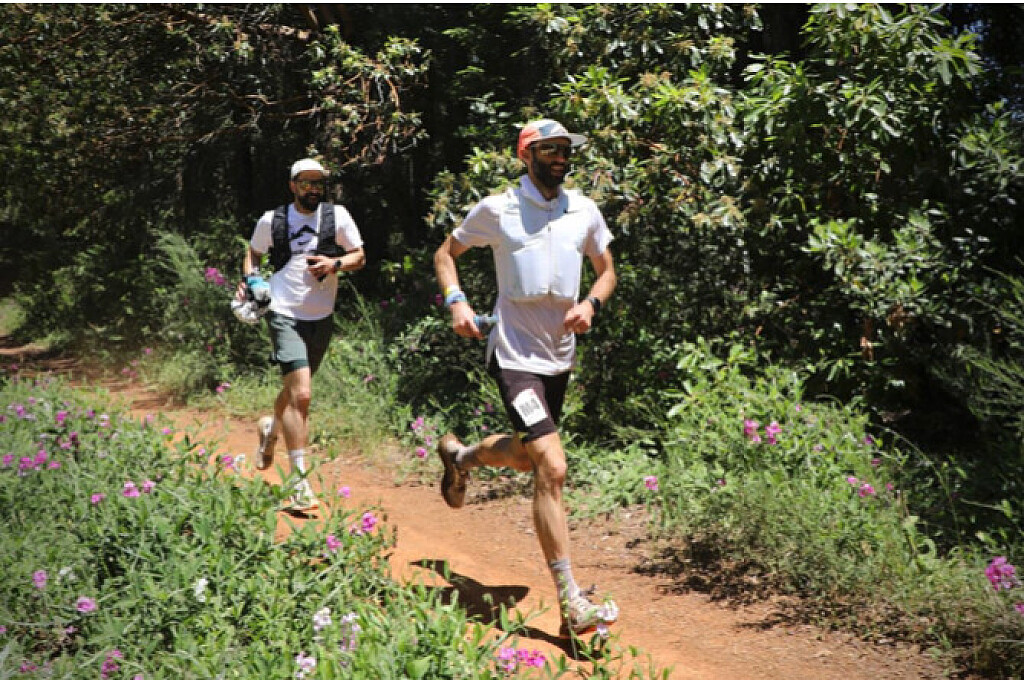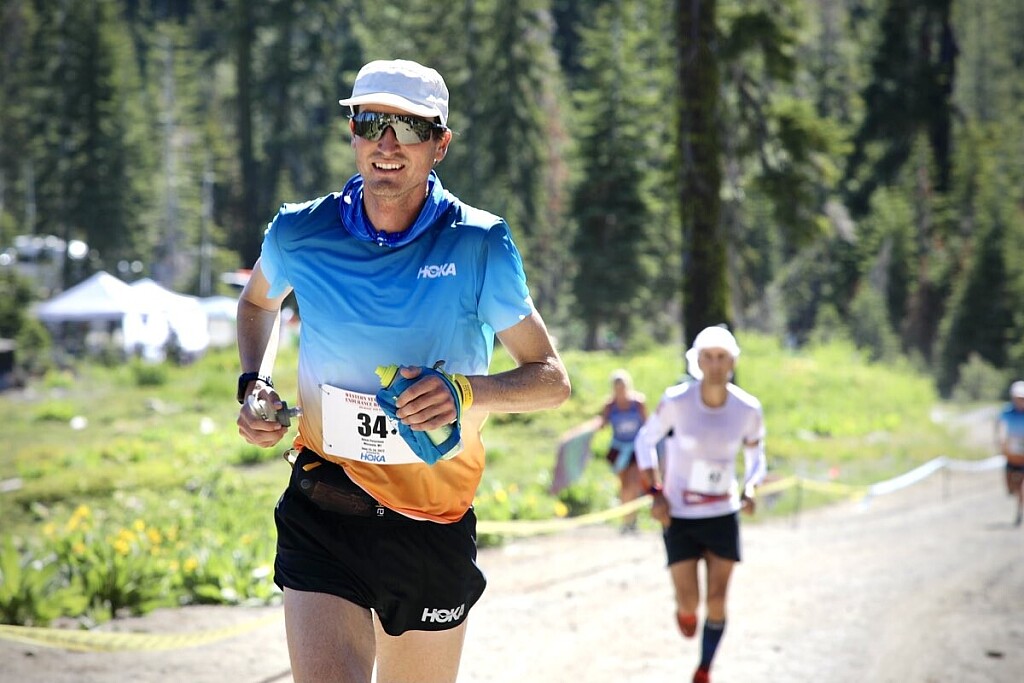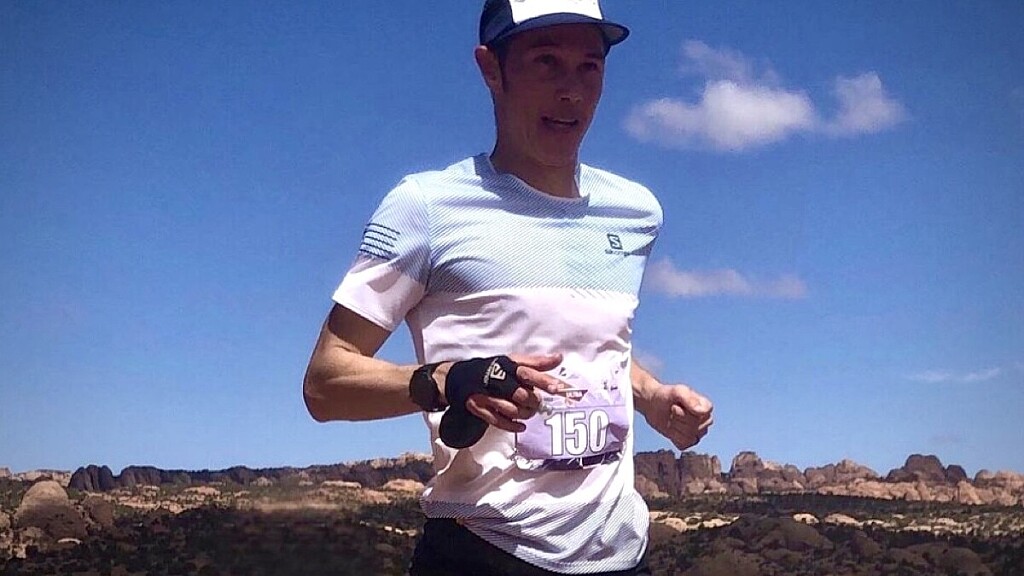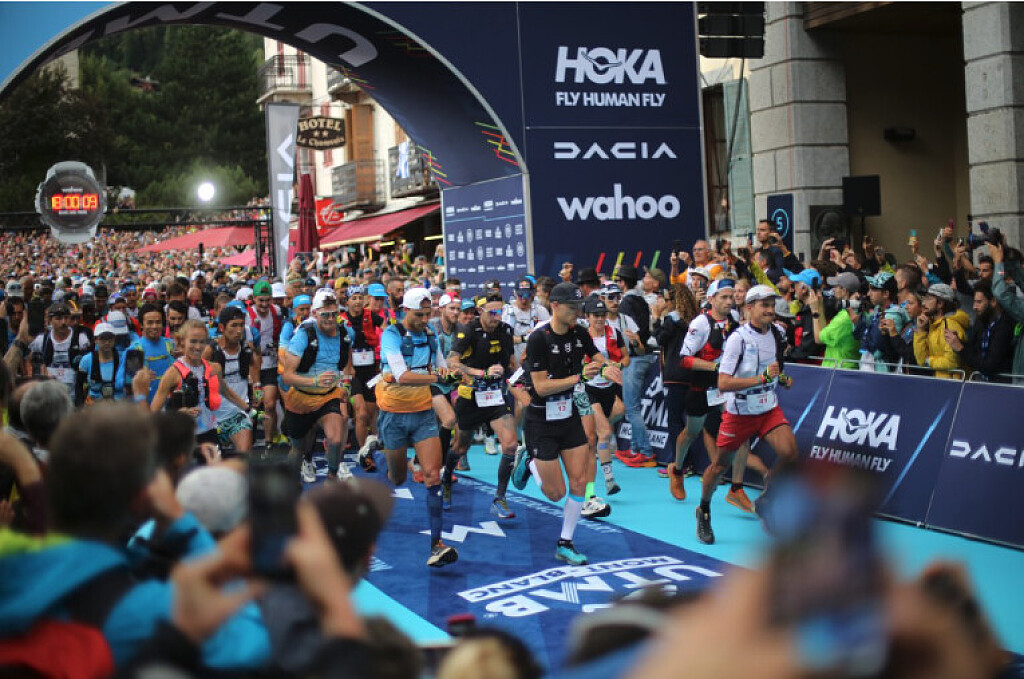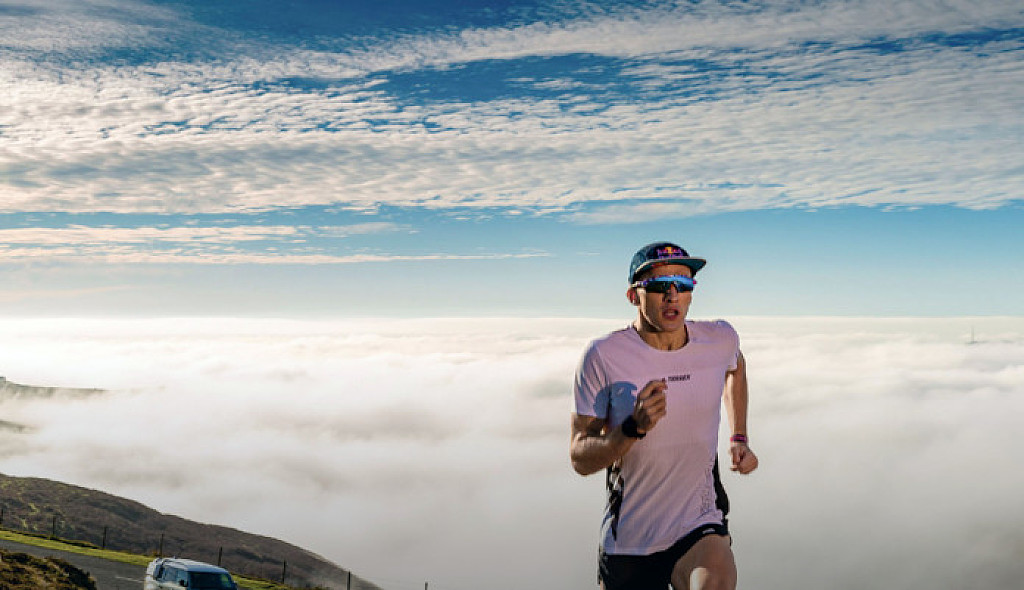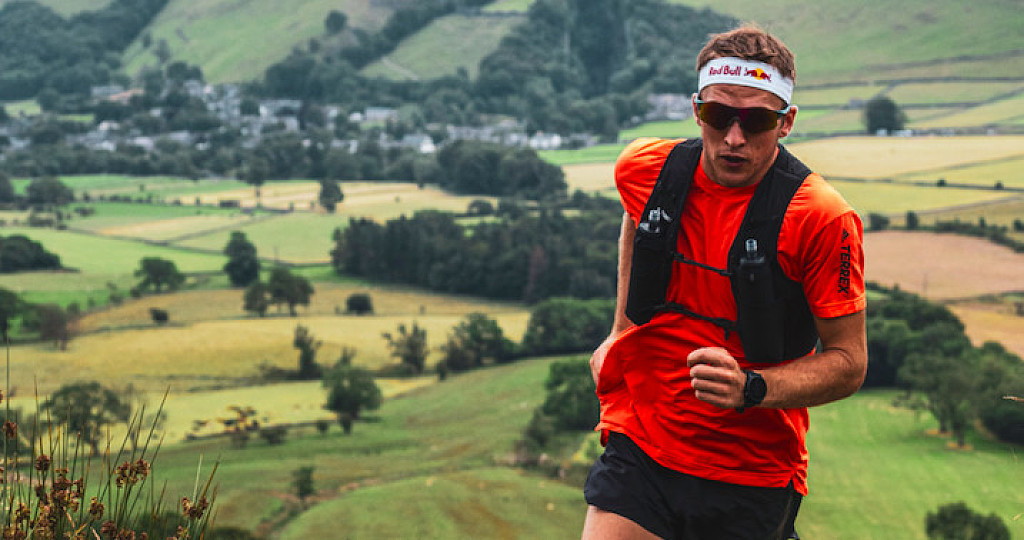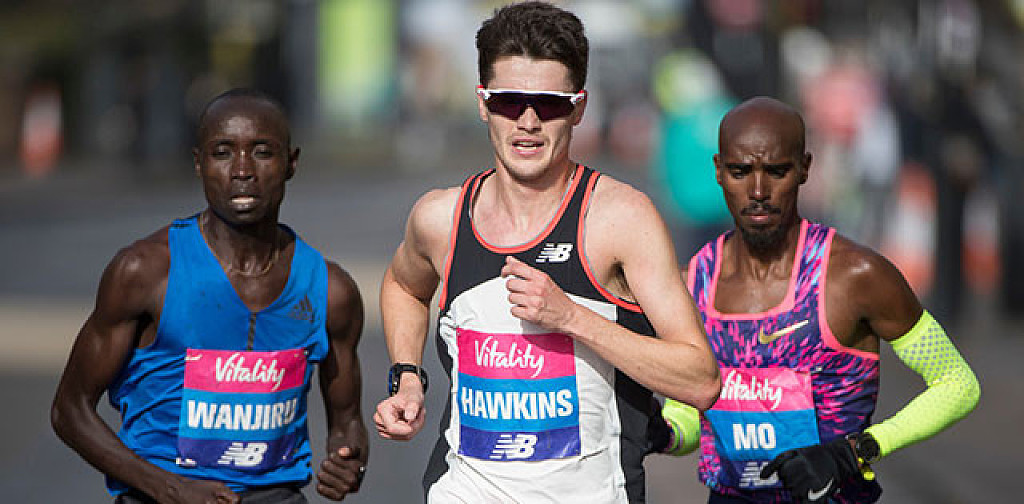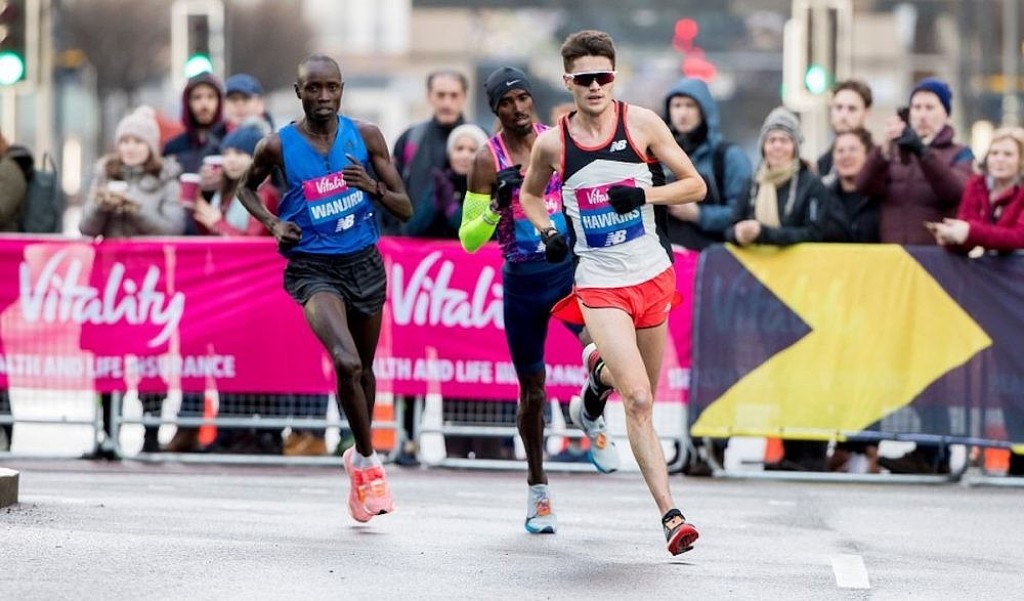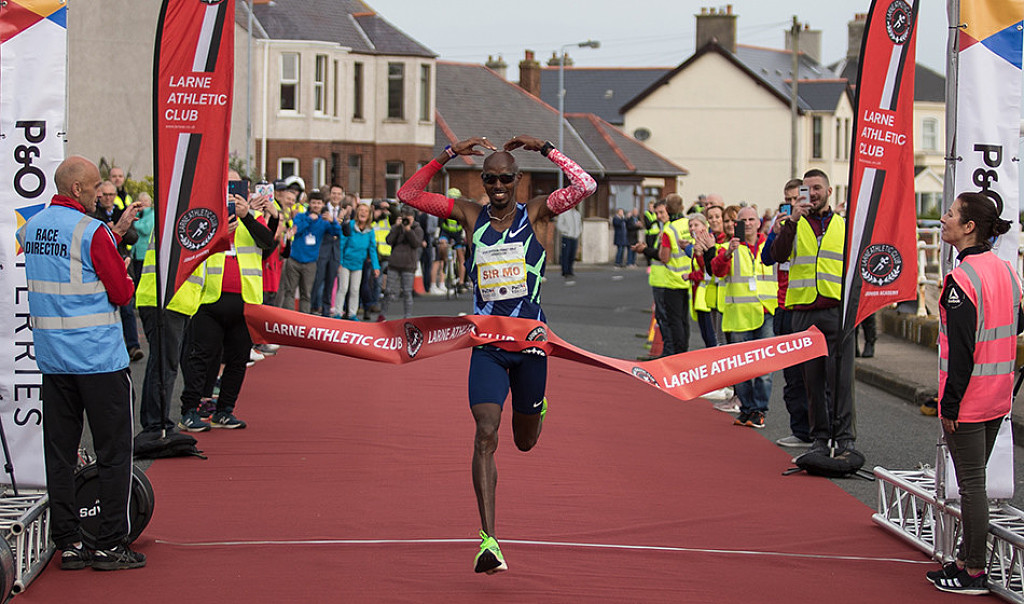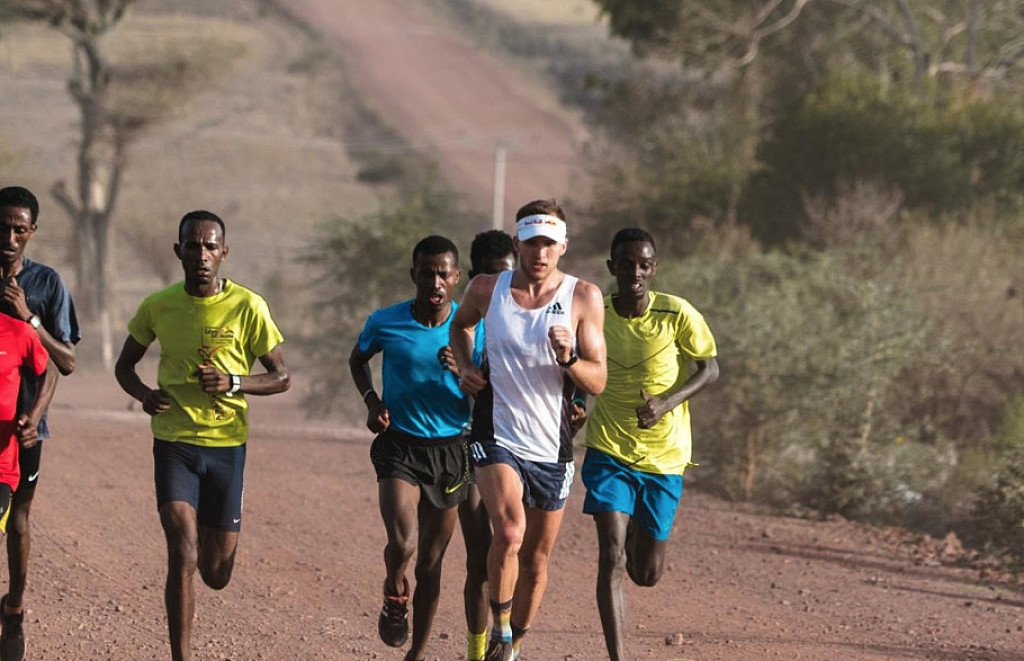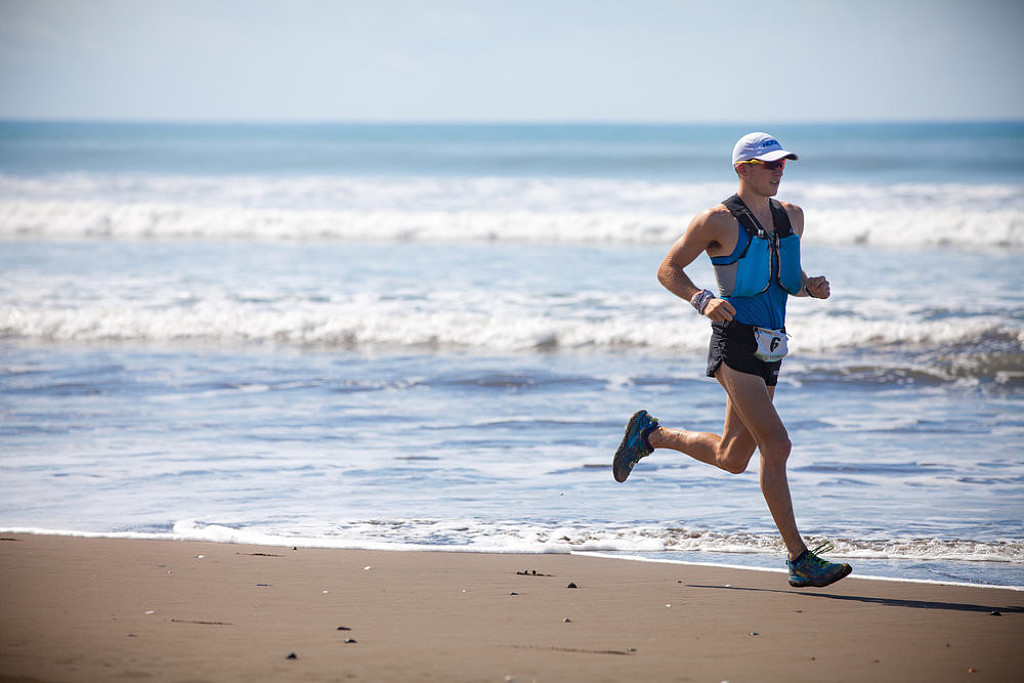Running News Daily
Running News Daily is edited by Bob Anderson. Send your news items to bob@mybestruns.com Advertising opportunities available. Train the Kenyan Way at KATA Kenya and Portugal owned and operated by Bob Anderson. Be sure to catch our movie A Long Run the movie KATA Running Camps and KATA Potato Farms - 31 now open in Kenya! https://kata.ke/
Index to Daily Posts · Sign Up For Updates · Run The World Feed
Articles tagged #Tom Evans
Today's Running News
Jim Walmsley, Mathieu Blanchard will return to UTMB in 2024
2023 UTMB champion Jim Walmsley and 2022 second-place finisher Mathieu Blanchard have confirmed they will appear at this year’s Ultra-Trail du Mont-Blanc (UTMB) final, which takes place in Chamonix, France on Aug. 30, according to a report by iRunFar. A number of other ultratrail elites have also been announced, including the U.K.’s Tom Evans, who finished third in 2022 and who won Western States 100 in 2023, and Canada’s Christian Meier, the former pro cyclist who won the 145-km TDS race last year.
On the women’s side, Canada’s Marianne Hogan (who finished second in 2022) is confirmed, as are 2022 champion Katie Schide of the U.S., France’s Claire Bannwarth and New Zealand’s Ruth Croft (who won Western States in 2022). (Three-time UTMB champion and course record holder Courtney Dauwalter does not appear on the list.)
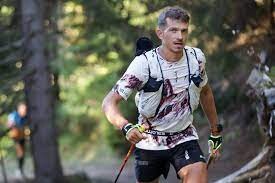
Four-time champion Kilian Jornet and 2023 second-place finisher Zach Miller will also not be returning. After the October, 2023 announcement by UTMB and its minority partner, the Ironman Group, of a new race in Whistler, B.C. in 2024, and the Dec. 1 announcement that UTMB livestream announcer Corrine Malcolm had been fired, the two publicly questioned the organization’s decisions and its treatment of athletes. There was talk of a boycott, though Jornet and Miller dispute this; in the wake of all of this, regular discussions between UTMB and the Pro Trail Runners Association (PTRA), of which Jornet is a founding member, became more frequent, with a view to smoothing relations between athletes and the race.
Walmsley moved to France for two years to hone his mountain-running skills before finally winning UTMB on his fifth try in 2023 (he Walmsley first ran UTMB in 2017, finishing fifth; he DNF’d in 2018 and again in 2021, then finished fourth in 2022). Blanchard, who has returned to France after living in Montreal for a few years (and taking out Canadian citizenship), finished fourth last year after following Jornet onto the podium in 2022. Hogan has been dealing with injuries for much of the last year and a half since her podium finish in 2022.
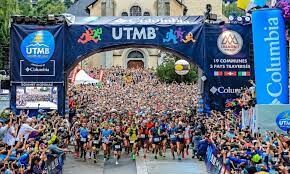
by Anne Francis
Login to leave a comment
North Face Ultra Trail du Tour du Mont-Blanc
Mountain race, with numerous passages in high altitude (>2500m), in difficult weather conditions (night, wind, cold, rain or snow), that needs a very good training, adapted equipment and a real capacity of personal autonomy. It is 6:00pm and we are more or less 2300 people sharing the same dream carefully prepared over many months. Despite the incredible difficulty, we feel...
more...The Wild, Uncertain Science of Post-Exercise Ketones
A new review study points toward post-exercise ketone supplementation as a way to improve adaptation and performance. What does the uncertain science mean for endurance athletes?
I heard about athletes supplementing with ketones sometime in the mid-2010s. A company reached out, promising the next big breakthrough in endurance performance from this liquid supplement composed of a molecule naturally produced in the body from the breakdown of free fatty acids. They told me that the top cyclists in the world were already using ketones and that it was destined to take over running, too. They sent a few boxes…and they collected dust in the pantry. It felt like a biohack, and I wasn’t comfortable with it.

Over the years, more studies on ketone ingestion emerged, and I started to get more and more intrigued. Rumors came out that about 70 percent of the cycling peloton used the stuff. But they cost a ton, and it was hard to discern what was actual practice and what was just marketing.
It wasn’t until 2023, though, that I embraced that ketones were here to stay, whether I liked it or not. A 2023 study in the American Journal of Physiology-Endocrine and Metabolism had nine men complete two cycling trials, both with one hour consisting of two minutes at 90 percent of aerobic capacity (moderately hard), followed by two minutes at 50 percent of aerobic capacity (very easy). In both trials, the cyclists consumed a carb-protein drink immediately after exercise and at one, two, and three hours later. Here’s the study intervention: in just one trial, participants ingested 0.29 g/kg ketone monoester immediately after exercise and at one and two hours later.
The ketone trial led to 20 percent higher levels of natural erythropoietin (EPO) in the bloodstream.
For comparison, a 2005 study in the British Journal of Sports Medicine found that the initial exposure to altitude training increased EPO by an average of around 50 percent in swimmers, with large individual variability (returning to baseline after a couple of weeks of altitude training), with lots of variation across studies. Given that our bodies produce EPO to increase red blood cell production, and red blood cells transport oxygen that power endurance performance, the ketone study indicated that we could be seeing a supplement that supercharges adaptation and performance.
Context for Ketones
To be 100 percent honest, I was sad when I saw this study. I love performance physiology, but I don’t want to think about a new biohack. Maybe it’s a sign that I’m getting old when a study on cutting-edge science just makes me tired. Get these research protocols off my lawn!
But I also couldn’t bury my head in the sand (though that would probably increase EPO concentrations via hypoxia). Instead of giving into my old-coach fatigue, maybe I can help publicize the emerging science so fewer athletes have an information disadvantage. My final push was last week when a fantastic review article was published in the American Journal of Physiology-Cell Physiology by Ruben Robberechts and Chiel Poffé. If ketone supplementation has the potential that some think it may, the article could be a key step in the future of exercise physiology.
Before getting to the science, I think it’s important to lay out the stakes. Based on the articles (mixed with a heaping dose of gossip), I can see three different scenarios unfolding over the next 10 years.
One, post-exercise ketones don’t live up to their promise, and this is all a nothingburger. That outcome would please me the most, and we all know that what’s most important in science is my pleasure. If researchers did this type of theoretical analysis on other interventions (i.e. heat training, Vitamin D, lifting, ashwagandha, strides, beta-alanine, doubles, creatine), they could come back with similar findings. We are only talking about a few intervention studies and lots of theory, and future research could have different results. Plus, some critics would already be confident making their judgments as the Supreme Court of Nothingburgerland.
Two, ketones could become a more commonly used supplement with benefits for performance and health (like iron). They are expensive, which isn’t great, but maybe they will help athletes be healthier and faster, with limited side effects. On the flip side, maybe more research indicates tradeoffs that lead to benefit:risk calculations with performance or health. Over email, Dr. Poffé–an author of the review study and a key researcher in this field–says that “studies have shown divergent effects on performance depending on the exercise context and whether you take them before, during or after exercise.” Even if they are beneficial in some contexts, it’s not a simple equation of take ketones = get faster.
The third possibility is that they are banned as an illegal performance enhancer. I have no inside info on whether that’s a possibility, and at first blush, it doesn’t seem likely without some health risks. Dr. Poffé says “I honestly don’t see much of a reason to ban ketones while allowing other ergogenic supplements.”
So, yeah, we’re talking about a wide range of possibilities, which makes sense given the uncertain mechanisms and effects at play. Let’s dig in. (We got even deeper into the nuance on our podcast this week, which you can listen to here.)
Introduction to Ketones
As stated by the review study, ketone bodies “are molecules that are continuously produced from the breakdown of free fatty acids,” primarily in the liver. Ketone body production is upregulated during periods of low carbohydrate availability—that’s why you have heard “ketosis” thrown around for ultrarunners who practice low carbohydrate, high-fat nutrition, aiming to improve fat oxidation and avoid bonking. Ketosis via nutritional interventions comes with way too many downsides for endurance athletes, though, including everything from reduced bone density to diminished high-intensity performance. That makes sense intuitively because low carbohydrate availability is extremely stressful on most body functions, especially the endocrine system.
Ketone esters, enter stage left. Researchers figured out how to create an ester bond between a ketone body precursor and a ketone body (first in 1978 in rats, but not undergoing human testing until 2012). These ketone esters cause a “rapid and transient increase in ketone bodies,” possibly inducing ketosis. It was as if this evolutionary mechanism honed over millions of years now had a dimmer switch. For the chemistry nerds out there, you can probably guess what oral ingestion of an ester is like—not fun. Companies like HVMN honed the taste over time, and now I’d say that ketone esters taste like a robot’s ass. We can only imagine what they tasted like before.
Ketones have mostly been marketed as a before-and-during-exercise supplement, at least in the podcast ads I have heard. Take ketones, burn more fat at higher intensities, win the Tour de France, etc. However, a bunch of studies have shown limited to no acute benefit. For example, a 2017 study in Frontiers of Physiology found that pre-exercise ketone supplementation caused around a two percent performance decrease in 10 male professional cyclists doing a 50-minute time trial.
Perhaps there’s some protocol being used in the cycling peloton that improves acute performance, as the marketing claims indicate. Heck, Tom Evans reportedly took ketone esters on his way to winning Western States, so there must be some benefit for some athletes (or at least neutral impacts), possibly related to perceived effort. Anecdotally, when I tried ketones on a fatigued long run, the lights went out. Thankfully, I had my phone to call the Wuber (when my wife Megan drives to pick me up).
So perhaps it’s something else. Maybe all this ketone hype is because taking them improves recovery and hematological variables, confounding variables that are actually the driving force behind their use (maybe that even explains some of the success stories behind low carb, high fat nutrition approaches. I’d love to see the blood work!).
According to the review, after exercise, circulating ketone bodies are increased. However, any benefits athletes may see from a sustained increase are blunted in advanced athletes practicing good recovery nutrition. Ketone esters “may induce a unique physiological milieu to enhance post-exercise recovery and exercise adaptation as it allows to benefit from the potential beneficial effect of post-exercise ketosis in combination with other nutritional exercise recovery strategies (e.g., carbohydrate-protein recovery drink).” They had me at physiological milieu. Dr. Poffé says that his lab started ketone work in 2016 when “there was already some preliminary data showing that it could help riders during the Tour de France as a recovery aid.”
Mechanisms of Post-Exercise Ketones
I can’t emphasize enough how great this review article is, summarizing extremely uncertain science and studies. Before getting to the EPO mechanisms, let’s briefly touch on a bunch of other considerations. First, ketone bodies may cause epigenetic changes. For example, histone lysine β-hydroxybutylation could increase with ketone body increases, which may “increase transcription of genes involved in the adaptive response to exercise.” Across several different epigenetic mechanisms, it’s possible that ketone bodies could be a signal to the body to adapt to stimuli (which makes sense given their evolutionary role in exercise in energy-limited environments).
Second, ketones could “enhance the restoration of cellular energy status after exercise” while also blunting AMPK phosphorylation, which could enhance recovery due to its role in cellular stress or decrease adaptation due to its role in mitochondrial biogenesis. I love this one because that maybe-good, maybe-bad uncertainty regarding downregulation of AMPK points out just how little is known about the long-term consequences of post-exercise ketones, particularly in conjunction with other impacts.
Third, ketones alter g-receptor signaling, which “mediate cellular responses to a wide variety of external agents.” Fourth, ketones show anti-inflammation and anti-oxidation properties, which seems good at first glance but could theoretically cause long-term reductions in training adaptations since the inflammation response can spur adaptation. Fifth, ketones may influence neurotransmitter concentrations in the brain, which could profoundly impact perceived exertion (and possibly even mental health, though that’s a topic for another day).
The next cohort of potential adaptations are at the cutting edge of science but still theoretical. Ketones could increase muscle glycogen resynthesis, reduce protein degradation and enhance protein synthesis, spur angiogenesis that leads to more capillaries to supply blood to working muscles, induce favorable changes in muscle mitochondria, and improve sleep quality in athletes who are training hard. You can put those variables together with a 2019 study in the Journal of Physiology, where male athletes completed a three-week overload training block with six days a week of two-a-day training sessions, with one group having post-exercise ketones. That study found higher tolerated training load in the ketone group and improved performance. (The study was the subject of a Letter to the Editor disputing some of the conclusions.)
A 2023 study looked at a similar three-week overload block, validating the findings. They had 18 male athletes complete 10 training sessions per week, with one group taking post-exercise and pre-sleep ketones and the other taking a placebo. The ketone group “increased the number of capillary contacts and the capillary-to-fibre perimeter exchange index by 44 percent and 42 percent,” plus “substantially increased vascular endothelial growth factor and endothelial nitric oxide synthase expression both at the protein and at the mRNA level.” And the money finding: EPO concentrations in the ketone group increased by 26 percent. That study was eye-opening for the possible recovery and adaptation benefits of ketones, and it brings us back to the elephant in the room: potential hematological changes from increased EPO production.
Hematological Changes
In 2018, a study in the Diabetes Care journal found increasing levels of EPO after a ketone body infusion. The authors of the 2023 study that started this article cited this study as part of the impetus for their investigation (read their amazing summary here). We’re seeing similar findings in athletes in the 2023 studies, which found 20 percent and 26 percent increases in EPO production in the ketone groups relative to controls. But the science is not there to make a definitive conclusion.
In the title of this article, I promised uncertain science, and now we are deep in it. First, we don’t know how much this EPO change may impact performance. “Currently,” the review says, “it has not been identified if the observed changes in EPO post-exercise are indeed sufficient to induce an improvement in hemoglobin mass and oxygen transport capacity in humans, and whether these effects are additive to stimuli that are frequently used by athletes to increases EPO such as hypoxia.” It’s possible that these changes don’t correspond to performance benefits.
And get a load of this: “The precise physiological mechanism underlying ketone body-induced upregulation of EPO is currently unknown.” However, based on mouse models, the researchers theorize that it relates to H39K acetylation in kidney cells.
Are Ketones the Future?
There are tons of unanswered questions. How do these types of adaptations change over time? The longest study right now is a few weeks.
Do the processes change in female athletes? That’s one of my big concerns in making any recommendations since metabolic processes can vary based on gender. While more research is needed, Dr. Poffé indicates that past studies likely show that the results can be extrapolated to female athletes. “In a recent, unpublished study,” he says, “we observed that some effects are even more pronounced in females.”
How about aging athletes? Athletes of different levels, with different goals and backgrounds? What’s the right dosage and timing? Would the same responses happen at altitude? Should consumption be periodized? With similar studies, would other interventions lead to similar findings? Should ketones be banned altogether?
I don’t know the answers to those questions, and a lot more studies are needed before I make coaching recommendations other than “be careful” and “keep it simple.”
“Similar to most nutritional supplements,” Dr. Poffé says, “the long term effects (e.g. what occurs if you supplement for multiple years) are not known.” When athletes take ketones, he says instead of taking them chronically, to supplement “during periods of limited recovery opportunities,” like training camps. From a performance perspective, he advises to consider ketones when everything else is sorted out around training, nutrition, and recovery. They are “the final step,” not the first one.
In September, after reading the research, I dusted off that old package of ketones and opened up a serving for myself. Then I threw it in the trash because it seemed like a health hazard after all those years. I ordered a new package and started experimenting with them a couple days a week post-exercise. In October, at the Blue Sky Marathon, I closed the final four miles two minutes faster than last year to set a course record.
That probably had nothing to do with ketones, right? I’m no Olympian, but I train hard. And when looking back on the race and why I could finish so fast while feeling so good, I would be burying my head in the sand not to consider one of the only variables that changed.
I’m not sure what the future holds with post-exercise ketone supplementation. Maybe it’s all snake oil and placebo, with some studies that find physiological anomalies without a demonstration that it fundamentally alters performance trajectories, destined to be covering dust in the pantry of exercise physiology history.
Or maybe we’re seeing the dawn of a revolution in endurance training and performance.
by David Roche (Trail Runner Magazine)
Login to leave a comment
America’s Oldest Continuously-Held Ultramarathon Is Only Looking Forward
After 60 years, the JFK 50 Mile Race is sticking to its community-centered approach, and people keep showing up
Mike Spinnler cries nearly every time he recounts memories as a runner and long-time race director of the JFK 50, the oldest continuously run ultra in the country.
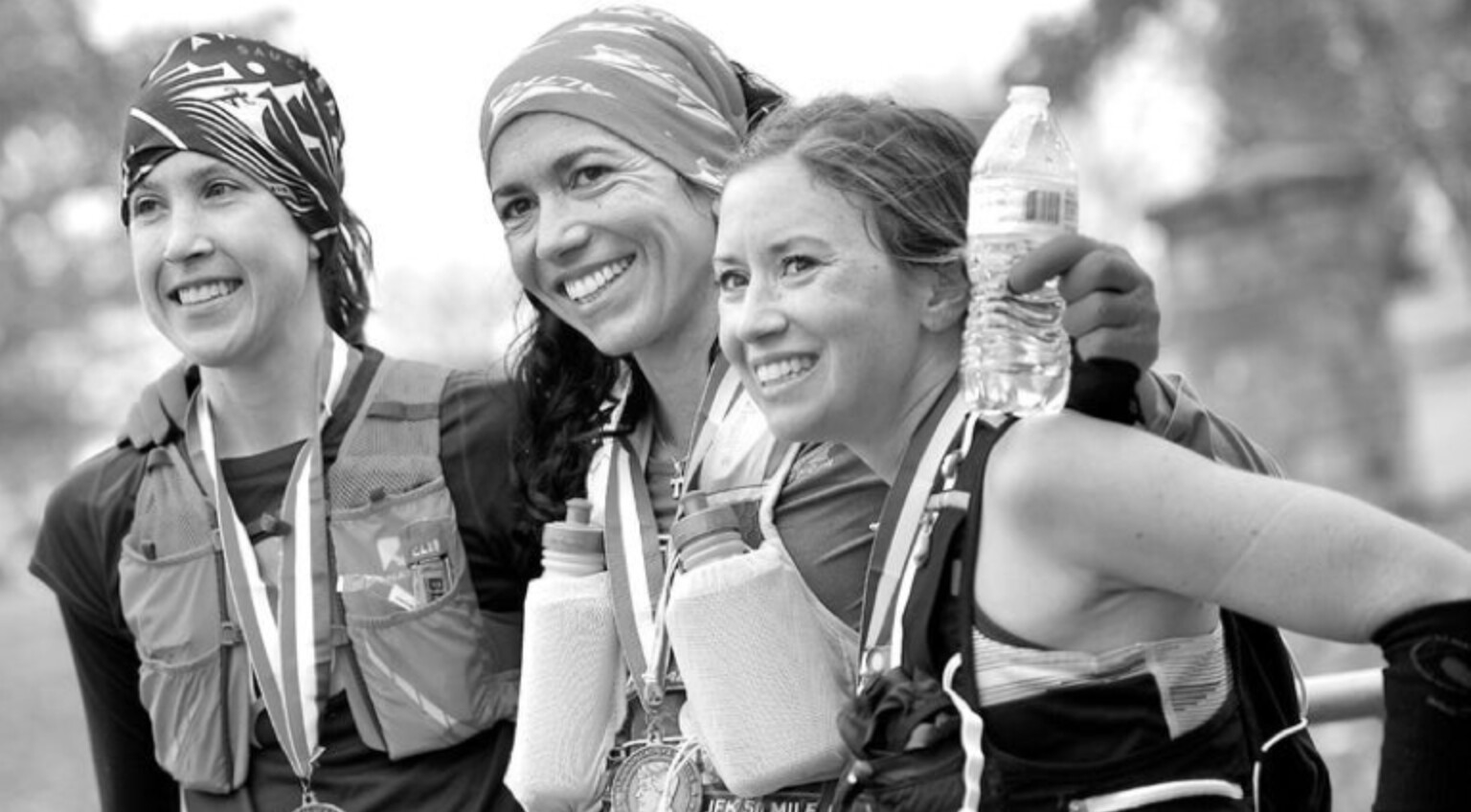
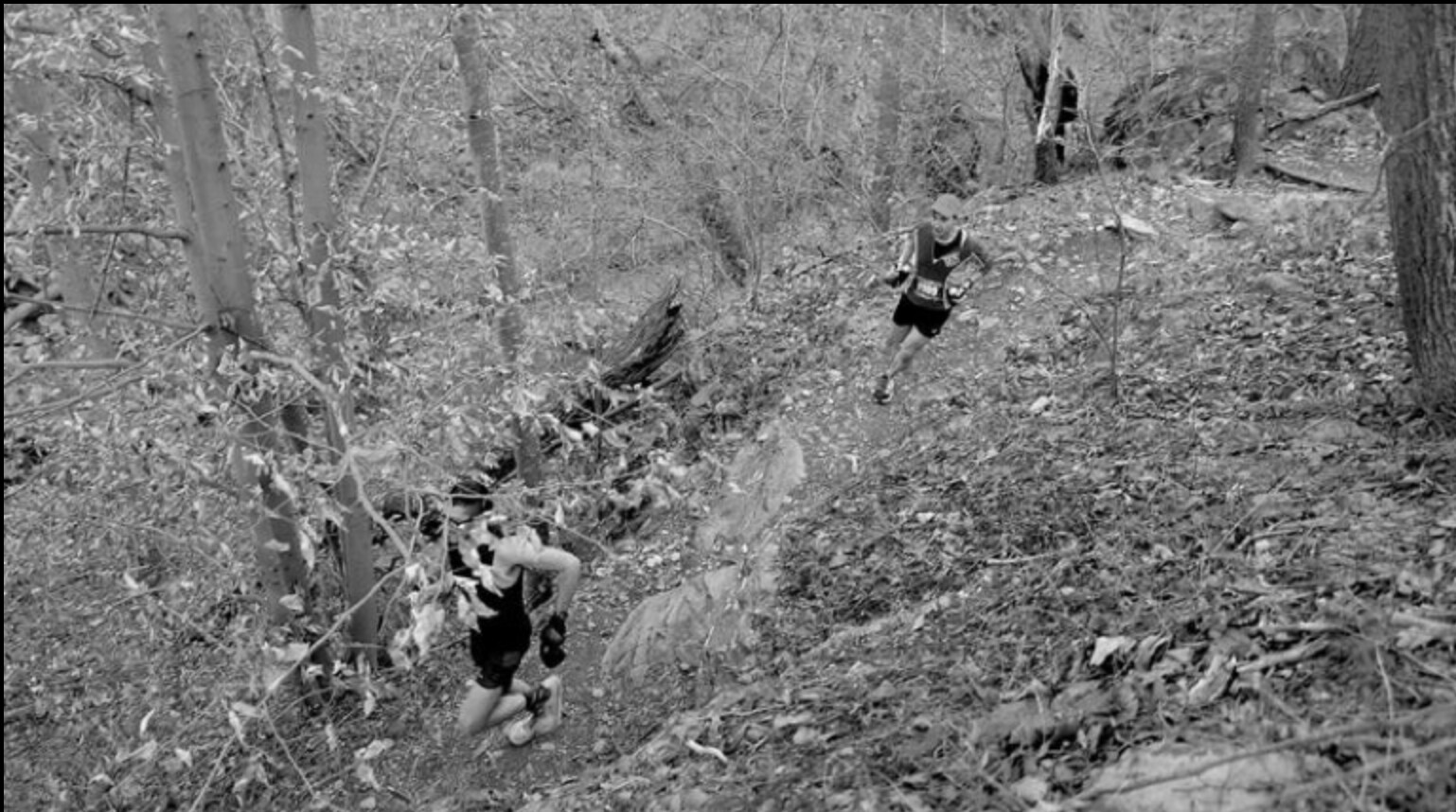
Such memories include the time he first ran the iconic Maryland race when he was 12 years old, or the year he cheered on his 60-year-old wife as she crossed the finish, or memories of watching his two sons racing. For him, this race is a member of the family.
In 1993, five years after his tenth JFK finish, Spinnler became the race’s second race director, where he’s been ever since. By then, he’d set the course record (5:53:05) in 1982, and added another win in 1983, for a total of five top-five and six top-ten finishes.
Thirty years later, it’s still his pride and joy. He’ll immerse in the magic of the event again on Saturday, November 18, as more than 1,000 runners take the journey through the historic route that’s so dear to his heart.
“It just keeps growing in its prestige,” he says.
The JFK 50 started in 1963, the same year President John F. Kennedy was assassinated. The president had instituted a public health program to improve the nation’s fitness, supporting the launch of a series of 50-mile races around the country. But as years went on, the only one that stuck around was the JFK 50.
“Kennedy’s mission was this: Improve your physical fitness, improve your lifestyle, improve your country,” says Spinnler. “We heeded his call and have been doing it for 60-plus years.”
The JFK 50 course is located about an hour northwest of Washington D.C., covering traditional lands of the Indigenous Massawomek and Shawandassee Tule (Shawanaki/Shawnee). One of the race’s primary appeals is that it’s a horseshoe-shaped, point-to-point course with three distinct sections: The Appalachian Trail (miles 0-15), the Canal/Tow Path (miles 15-42), and the rolling finish (miles 42-50).
The race starts in Boonsboro, Maryland, follows a few miles of paved roads before connecting with the Appalachian Trail (AT), where the course climbs more than 1,000 vertical feet in five miles, crests to the high point, and follows rocky singletrack before dropping 1,000 vertical feet halfway into the race (mile 14.5), to connect with a flat marathon distance along the C&O Canal Tow Path. The last several miles are rolling country roads, where it finishes at Springfield Middle School in Williamsport.
In 2019, Seth Ruhling, an unsponsored athlete, showed up to the JFK 50, slept in his car the night before, and won the race in a blistering 5:38:11, his debut 50-miler. Within hours of winning, he sealed a sponsorship with The North Face.
Ruhling, 29, now lives and trains in Boulder, Colorado, and he’ll be returning for his second JFK 50. Since Ruhling’s 2019 win, he has made a name for himself with a sixth place finish at the Pikes Peak Marathon in 2021, second place at Montana’s Rut 50K, first place at the Broken Arrow Skyrace 46K, and most recently, sixth at CCC 100K during the week of UTMB in Chamonix, France.
In 2020, JFK 50 was one of the only races in the country that didn’t shut down with the pandemic. Ruhling had planned on racing, but got injured. “I always wanted to go back,” he says.
Ruhling was particularly drawn into this year’s race because of its deep field of registered elites, which had at one point included 2023 Western States winner Tom Evans, Matt Daniels, Adam Merry, and Sean Van Horn—all of whom have since dropped.
His strategy for the mixed course, which requires technical trail chops as well as fast road turnover, is to attack every single section. He says that, while the JFK 50 is known more as a “track race,” it’s a mistake to discount the early trail miles. “The record is going to happen on the towpath, sure, but only if it’s set up with efficient running on the AT section,” he says.
by Outside Online
Login to leave a comment
2023 UTMB Men’s Race
After a history of struggling with UTMB, the American men showed up this year with Jim Walmsley and Zach Miller (pre-race interview) taking the top two-spots on the podium. Two vastly different racers with different approaches to the event, the two were able to push each other from start to end, with Walmsley’s ever-consistent pace finally winning out in the end with a new course-record time of 19:37:43. But with a stacked field, with nine of last year’s top 10 back for another crack at the race, and last year’s champion Kilian Jornet out with injury, it was anyone’s bet throughout most of the race of who would come out on top.
There’s never a non-chaotic start to UTMB, and this year was no different. With nerves and excitement running high, it was France’s Arthur Joyeux-Bouillon (pre-race interview) who led at Saint-Gervais, 21 kilometers in, with the entire rest of the field hot on his heels. But as darkness fell on the race and the kilometers ticked by, several distinct groups began to form. Coming into Les Contamines, 32 kilometers in, it was Zach Miller, Jim Walmsley, and the U.K.’s Tom Evans (pre-race interview) bunched up and running together. It looked like there would be the potential of a repeat of the Miller-Evans bromance from 2022, with the addition of Walmsley as a third. Frenchman Mathieu Blanchard (pre-race interview) and Petter Engdahl (pre-race interview), a Swede who lives in Norway, teamed up just a minute behind the leading trio, and the rest of the top-10 men came in within five minutes of the leaders.

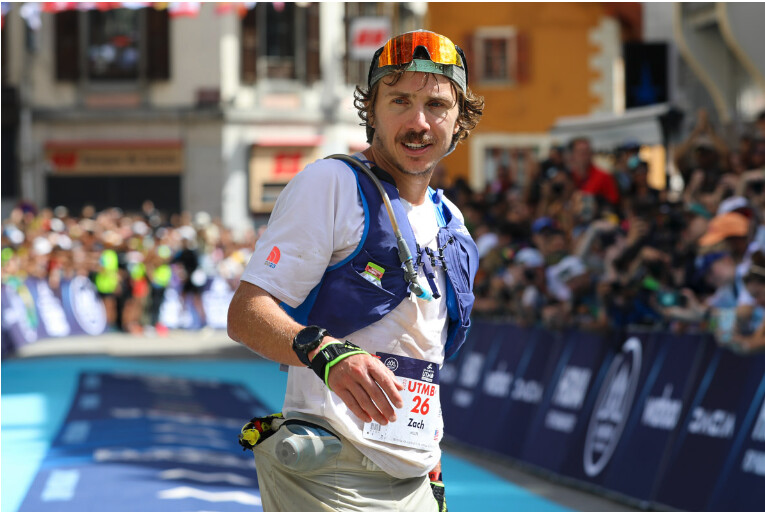
By Col du Bonhomme at 44 kilometers, it was clear that Walmsley was there to put his mark on the race. Miller doggedly hung on 30 seconds back, and Evans came through another 30 seconds in arrears, looking decidedly worse than the two men in front of him. France’s Germain Grangier (pre-race interview), Blanchard, Engdahl, and Joyeux-Bouillon continued to run together just eight minutes off the lead.
The head of the race remained amazingly consistent over the coming kilometers to Courmayeur, 81 kilometers into the race. Walmsley led Miller by a handful of minutes, Engdahl and Grangier followed, running close to each other in third and fourth, at under 20 minutes back after Evans decided to call it a day. Joyeux-Bouillon and Blanchard stayed within half an hour of the leader in fifth and sixth.
Ever the aggressive racer, Miller made his move before Arnouvaz, 99 kilometers in. He came through the checkpoint leading a fatigued-looking Walmsley by two-and-a-half minutes. Many wondered if this was just another instance of Walmsley taking the early race out too hard and paying for it later. Grangier, Joyeux-Bouillon, and Engdahl all came through the checkpoint within 30 minutes of Miller, still well within striking distance if either of the two Americans fell back. The rest of the top-10 men also remained close, with a large group containing New Zeakland’s Scotty Hawker, France’s Thibaut Garrivier, Blanchard, Switzerland’s Jean-Philippe Tschumi, and Germany’s Hannes Namberger coming in hot and fast.
Coming over a dark and foggy Grand Col Ferret at 103 kilometers, Miller extended his lead to nearly four minutes, but Walmsley looked determined and seemed to have found a second wind. Grangier continued to hold strong just 12 minutes behind the leader, and the chase pack of the rest of the top 10 remained relatively unchanged with several of the men teaming up to run the final kilometers to daybreak together.
It’s always a question of when the actual racing at UTMB starts. That is, when do runners make their move and hope that it sticks? Coming into Champex-Lac at kilometer 126 on Saturday morning, it was starting to seem like perhaps Miller’s early move might be the one that worked for the American. With an 11-minute gap over Grangier and Walmsley, who were now running together, Miller looked strong and focused. But there was still a lot of racing to do, and a lot of mountains between him and the finish.
Whether Walmsley was actually in a spot of bother in the later hours of the night, or if it was all part of his strategy to hold back until daylight, everything changed when the sunlight lit up the Alps. By kilometer 139 at La Giète, he’d whittled his gap to Miller down to two minutes, and by Trient six kilometers later, he’d moved back into the lead of the race, a position he wouldn’t relinquish. Grangier continued to run in third, with fourth, fifth, and sixth place, Joyeux-Bouillon, Blanchard, and France’s Ludovic Pommeret, all moving together 44 minutes back from the battle up front.
With the kilometers ticking by, Walmsley’s lead only continued to grow. At kilometer 154 at Vallorcine, he was more than 13 minutes ahead of a struggling Miller. Seven kilometers later at Tête de Béchar, the gap was up to 16 minutes. From here, it would be just one more climb up to La Flégère before the course tipped downward to Chamonix. Grangier maintained his third place up the final climb, with Blanchard in fourth and Pommeret in fifth, more than an hour back on the leader. Garrivier ran in sixth, while Hawker and Joyeux-Bouillon were seventh and eighth, 92 minutes back from the lead.
Once on the final descent, there was no touching Walmsley, and one can only imagine the thoughts and emotions that must have been going through his head. After five attempts at the race, the ultimate student of the course had finally figured out how to put together the race everyone thought he was capable of. He crossed the finish line to huge cheers from the crowd with a time of 19:37:43, breaking Kilian Jornet’s course record of 19:49:30. Wiping away tears while receiving congratulations from past UTMB champion François D’Haene, it was clear how much this victory meant to him.
Fellow American Miller came across the line in second with a time of 19:58:58, looking completely spent. This was his best finish during what can only be called an extended relationship with UTMB starting in 2016. Granger completed the podium with a 20:10:52.
Blanchard, last year’s second-place UTMB finisher, ended just off the podium in fourth. Maybe one of the more impressive results of this years race was of Pommeret in fifth. The 48-year-old masters athlete, who was the 2016 UTMB champion and 2022 TDS winner, showed that age really is just a number. The other surprise in the top 10 has to be Tyler Green, the American who made a late race move to finish in seventh. He didn’t move into the top 10 until Tête de Béchar, 161 kilometers in.
Race favorite Petter Engdahl withdrew at Champex-Lac, 126 kilometers into the race.
by Eszter Horanyi I run far
Login to leave a comment
North Face Ultra Trail du Tour du Mont-Blanc
Mountain race, with numerous passages in high altitude (>2500m), in difficult weather conditions (night, wind, cold, rain or snow), that needs a very good training, adapted equipment and a real capacity of personal autonomy. It is 6:00pm and we are more or less 2300 people sharing the same dream carefully prepared over many months. Despite the incredible difficulty, we feel...
more...Kilian Jornet pulls out of UTMB with injury
While the roster of talented athletes ready to jostle for the win at the 171-km Ultra Trail du Mont Blanc (UTMB) on Sept. 1 is still ridiculously deep, one notable competitor will be absent: four-time winner and course record holder Kilian Jornet.
The athlete announced on social media Thursday that he would not be attending due to an injury that hasn’t healed. “No UTMB for me this year,” Jornet shared. “I still can’t run due to the sacrum injury so we decided it was better to prioritize a good recovery and try to do something fun when the pain disappears.”
Fans were eager for a rematch between Jornet and Canadian Mathieu Blanchard, who will be vying for his third consecutive podium finish in Chamonix. Blanchard ran last year’s race in 19 hours, 54 minutes and 50 seconds to finish a close second behind Jornet, who ran 19:49:30, setting a new course record.

Jornet battled through injury in the Eiger Ultra Trail by UTMB, vying for a UTMB Running Stone that would allow him to compete in the final UTMB event in Chamonix. While Jornet leads the UTMB Index with a 945 rating, he needed to finish the race to become a contender in the final. The athlete injured his sacrum in training two days before Eiger Ultra, but fought through to finish in 48th place in a race won by 16-year-old Swiss athlete Lorick Buclin (1:21:26).
“Some days before Eiger Ultra trail I started to feel pain in my right hip, Jornet shared on Instagram. “I thought it was a muscle problem or tendinitis that would go away with some easy days, but after a check we found out it’s a bone edema.” The multi-sport mountain athlete explained that he suspected the cause was returning to big running weeks too quickly after a Himalayan expedition that left him with broken ribs and a hip injury.”It feels it’s a bad timing to get this injury so close to the races but managing injuries and recovery is part of an athlete’s life,” he said.
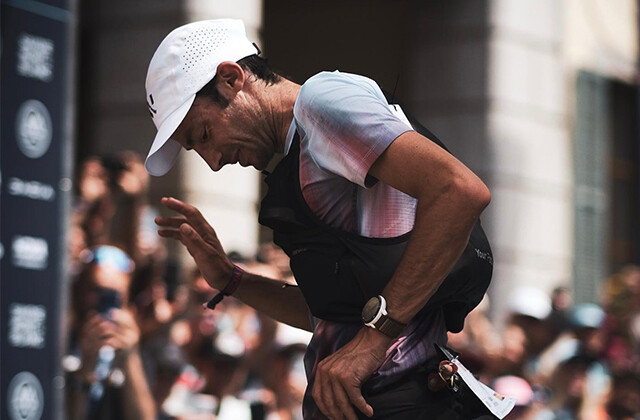
While Jornet expressed hopes in late July that he would be able to line up along the likes of Americans Jim Walmsley and Courtney Dauwalter, British ultrarunner Tom Evans and Canadian Blanchard, the athlete decided against it. Fans can hope to see him crewing his wife, Swedish ultrarunner and ski mountaineer Emelie Forsberg, who will be lining up at CCC (Courmayeur–Champex–Chamonix), the 100K race at the UTMB World Series Finals.
Jornet is somewhat of a legend at UTMB, first winning the race in 2008 as a 20-year-old and returning to win 2009, 2011 and 2022. Jornet has a long list of accomplishments and holds the fastest known time speed record for the ascent and descent of major mountains, including the Matterhorn and Mont Blanc.
by Keeley Milne
Login to leave a comment
North Face Ultra Trail du Tour du Mont-Blanc
Mountain race, with numerous passages in high altitude (>2500m), in difficult weather conditions (night, wind, cold, rain or snow), that needs a very good training, adapted equipment and a real capacity of personal autonomy. It is 6:00pm and we are more or less 2300 people sharing the same dream carefully prepared over many months. Despite the incredible difficulty, we feel...
more...Montreal ultrarunner Mathieu Blanchard to join star-studded UTMB field
Montreal’s Mathieu Blanchard has confirmed he will toe the start line at Ultra Trail du Mont-Blanc in two weeks, joining an elite lineup that organizers of the 171-km race are billing the strongest elite field since the race began 20 years ago.
Blanchard will be vying for his third consecutive podium finish in Chamonix on Sept. 1. He ran last year’s race in 19 hours, 54 minutes and 50 seconds to finish a close second behind Spain’s Kilian Jornet, who ran 19:49:30 for a new course record. In 2021, Blanchard finished third behind French runners François D’haene (20:45:59) and Aurélien Dunand-Pallaz (20:58:31).
In June, Blanchard ran 15:37:02 to finish sixth in his Western States Endurance Run debut. He told Canadian Running after the race that Western States presented a uniquely difficult challenge: “I pushed through, I fought hard, my body was super painful like never before,” he said, adding he was proud to earn the “mythic buckle” awarded to Western States winners.
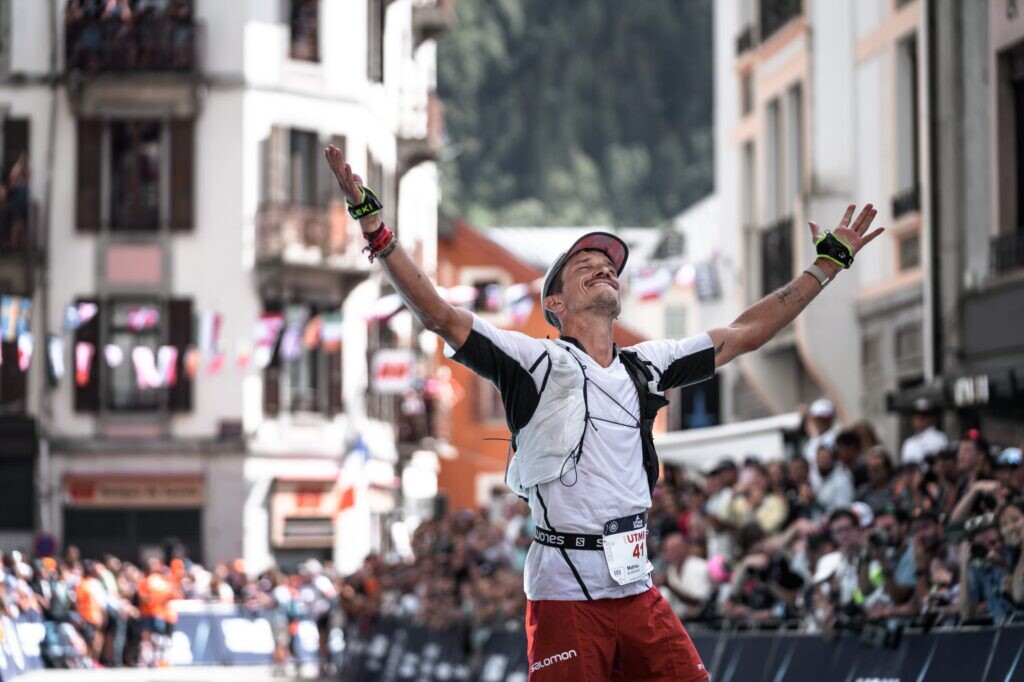
Among the giants of trail running Blanchard will be up against at UTMB is British runner Tom Evans, who ran the fourth-fastest time in Western States history (14:40:22) to win this year’s men’s race, and who finished behind Blanchard at last year’s UTMB to place third (20:34:35).
“I’m incredibly enthusiastic about the idea of taking part in the UTMB this year,” Evans recently told UTMB. “I’m coming into the event in a much better position than last year when I was fresh from a knee operation. The race is so full of history and for the 20th anniversary, I want to be part of the story by doing a Western States 100 Endurance Run and UTMB double. It’s a big challenge and with the strength of the peloton, it won’t be easy, but it’s a contest I’m looking forward to and believe I can achieve.”
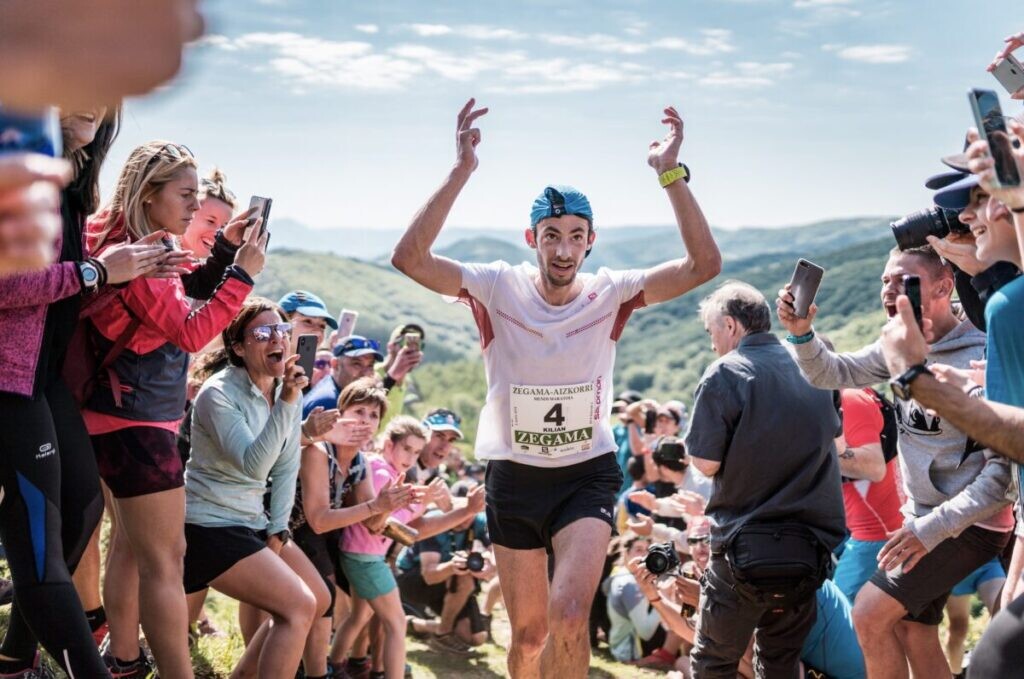
In addition to Jornet, this year’s men’s field will see the return of American Jim Walmsley, who finished fourth in last year’s race (21:12:12) and who has held the Western States course record (14:09:28) since 2019.
Other notable entries in the men’s field include Swiss runner Jonas Russi (winner of the Lavaredo Ultra Trail by UTMB 2023), fellow Swiss runner Jean-Philippe Tschumi (who shared victory at the 100K Trail 100 Andorra by UTMB with the American Ben Dhiman) and Sweden’s Petter Engdahl.
Arguably the most compelling storyline from this year’s UTMB will be American trail running phenom Courtney Dauwalter‘s quest for the triple crown following her resounding victories at Western States (where she ran 15:29:33 to smash the 16:47:19 course record set by Canadian Ellie Greenwood in 2012) and Hardrock 100 (where she set a new course record in 26:14:08). The Golden, Colo.-based runner won UTMB in 2019 (24:34:26) and again in 2021, when she set the current women’s course record (22:30:54).
She stands to face fierce competition from an elite field that includes New Zealand’s Ruth Croft (who finished second at Western States last year), Germany’s Katharina Hartmuth (winner of this year’s Eiger Ultra Trail by UTMB), Italy’s Martina Valmassoi (winner of the 2022 TDS in Chamonix) and Hungary’s Eszter Csillag, who finished fifth at last year’s UTMB.
by Paul Baswick
Login to leave a comment
North Face Ultra Trail du Tour du Mont-Blanc
Mountain race, with numerous passages in high altitude (>2500m), in difficult weather conditions (night, wind, cold, rain or snow), that needs a very good training, adapted equipment and a real capacity of personal autonomy. It is 6:00pm and we are more or less 2300 people sharing the same dream carefully prepared over many months. Despite the incredible difficulty, we feel...
more...Don’t tell me what’s impossible – Tom Evans confirms UTMB is up next
Tom Evans has announced that he will run at this year’s Ultra Trail du Mont Blanc (UTMB) after a late alteration to his 2023 plans.
The British runner claimed a “dream” victory at Western States last month to add to his “super fun” Ultra-Trail Snowdonia win in May and second place at Black Canyons 100K in February.
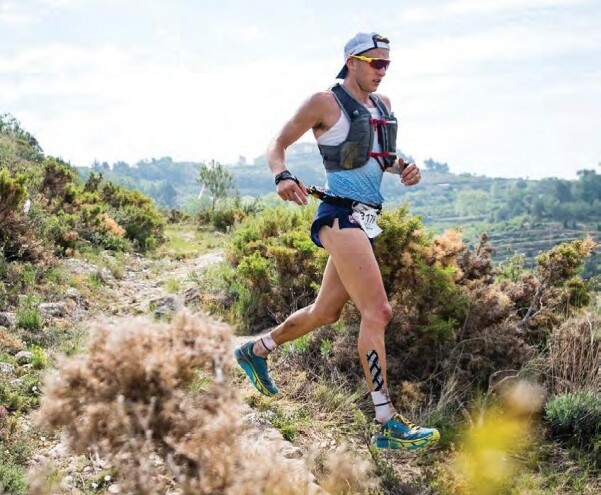
Evans crowned his return from knee surgery to finish third behind Kilian Jornet at last year’s UTMB, but had not scheduled in the iconic Chamonix race for 2023.
Western States recovery

His race calendar for this year, which he shared on Instagram in January, included a Fastest Known Time (FKT) attempt of the Bob Graham Round in September, but there was no mention of UTMB following Western States.
However, after his dominant win in California’s Sierra Nevada Mountains, a defiant Evans suggested that UTMB could still be on the cards.
“If I recover well from this, I’ll race UTMB this year,” Evans said at the end of adidas TERREX’s documentary on his Western States win.
“People have said it’s impossible to do. Don’t tell me what’s impossible or not.
Irresistible challenge
Over the next three weeks, Evans’ recovery clearly went to plan and yesterday he revealed that he was unable to resist the allure of UTMB, which takes place next month.
“Couldn’t resist the chance to make more memories like this,” he wrote on Instagram. “See you in Chamonix!
“Next up… UTMB.
“The Western States 100 / UTMB double is something that has always interested me. It wasn’t on my original plan but things have to change with how you’re feeling!
“And now, I can’t wait for the challenge!”
by Olly Green
Login to leave a comment
North Face Ultra Trail du Tour du Mont-Blanc
Mountain race, with numerous passages in high altitude (>2500m), in difficult weather conditions (night, wind, cold, rain or snow), that needs a very good training, adapted equipment and a real capacity of personal autonomy. It is 6:00pm and we are more or less 2300 people sharing the same dream carefully prepared over many months. Despite the incredible difficulty, we feel...
more...2023 Western States 100 Men’s Race
There’s nowhere to go but up at the start of the Western States 100, and Jia-Ju Zhao from China charged the opening climb. Despite snow, Zhao hit the top in 42 minutes. Slower to the top, Frenchman Mathieu Blanchard (pre-race interview) and Brit Tom Evans (pre-race interview) turned to greet the brilliant sunrise together.
Zhao won the Ultra-Trail Mt. Fuji 100 Mile in April 2023 and is a two-time winner of the Doi Inthanon by UTMB 100 Mile in Thailand. He pushed his early lead to five minutes at Lyon Ridge, mile 11, while 2022 fourth-placer Tyler Green led the early chase group. Green had finished as high as second here before, in 2021, but was running more aggressively toward the front earlier than ever before.From mile-15 Red Star Ridge to mile-25 Duncan Canyon, the chase group started to make up time on Zhao. Tom Evans, Chinese runner Jia-Sheng Shen, and Dakota Jones (pre-race interview) were among a group that cut four minutes from Zhao’s lead over just nine miles. Evans was third here in 2019 in 14:59, and Jones had just biked 680 miles from his home in Utah to the race start.
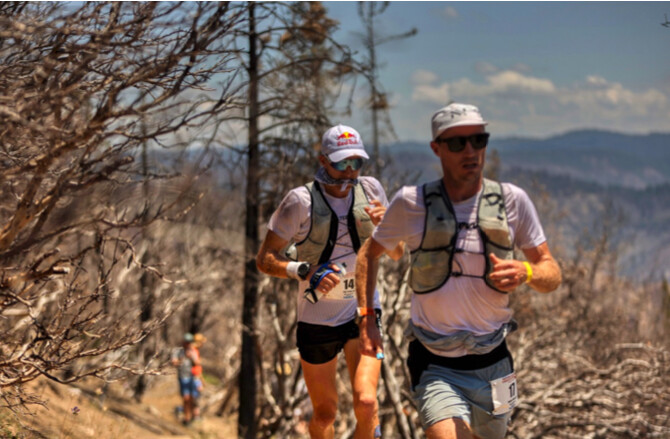
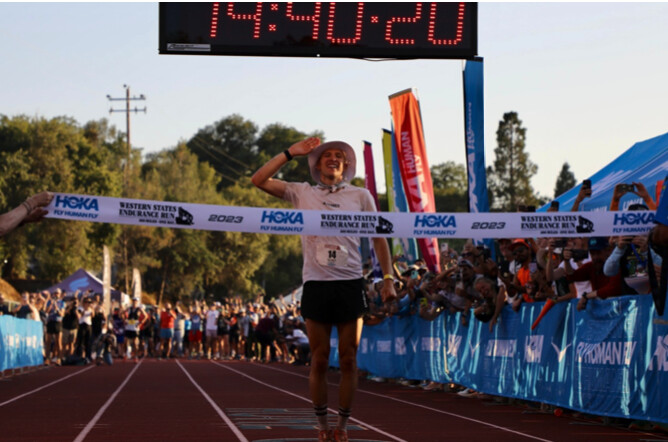
Zhao was quickly swallowed up in the next five miles to Robinson Flat, mile 30, and soon fell out of the top 10. A lead trio of Tom Evans, Dakota Jones, and Jia-Sheng Shen came into aid at 4:45, meeting their crews for the first time. At mile 30 and with Zhao falling backward, Anthony Costales (pre-race interview) was fourth, and then he was with Tyler Green at mile 38 in fourth and fifth. The two would barely separate the rest of the race.Evans and Jones dropped Shen on the climb to Devil’s Thumb, mile 48, and the two leaders came into aid together in 7:03. Four minutes back Costales had caught Shen on the big climb, and Tyler Green, Jeff Colt, New Zealand’s Daniel Jones, Ryan Montgomery, Mathieu Blanchard, and 47-year-old Ludovic Pommeret were inside the top 10. Those six were 14 minutes apart. 2022 third- and second-place finishers Arlen Glick (pre-race interview) and Hayden Hawks (pre-race interview) were back in 11th and 16th, respectively. After earlier moving up, Hawks had just lost several places and would later drop with injury at mile 55. Other top-10 finishers from 2022 Cody Lind, Scott Traer, and Alex Nichols were all noticeably outside the top 10 too.
As the race shifted to its mile-62 Foresthill hub, Evans gained some separation on Jones and entered the aid station first, but as Evans changed shoes and socks, Jones didn’t wait and exited first. Jones was now in the lead by himself for the first time and he was overheard voicing his intention to break Evans. Some 11 minutes back of those two leaders, Green and Costales were again together and in third and fourth. Shen and Jeff Colt were just minutes back of those two, and Colt was remarkably almost an hour faster than a year ago when he finished 11th.Jones and Evans separated leaving Foresthill and anticipation ran high for their next steps. The two had been together for nearly the entirety of the race to this point. Jones wanted to make a move and Evans wanted to keep up with (the) Jones. The duel ended quickly and dramatically though. Tom Evans dropped a 5:54 downhill mile and hit Cal 2, mile 71, in 10:12. That surge pushed Jones eight minutes back at mile 71. It was just nine miles from Foresthill to that split on Cal Street, but the front two had shattered and moved in opposite directions the rest of the race.
Evans ran alone to the river crossing at mile 78, and ultimately to the finish. Tyler Green, Anthony Costales, Jeff Colt, and Jia-Sheng Shen all overtook Dakota Jones on the way to the river too. Forget about Elm Street, Jones was having a bit of a nightmare on Cal Street.
Evans, the 2022 UTMB third placer, continued to put time on the field the rest of the way. He finished in 14:40 and that’s the race’s fourth fastest finish ever. The mark trails only Jim Walmsley and Jared Hazen in 2019, and Walmsley’s 2018 mark too. Evans was a runaway winner, but the rest of the top 10 was much more closely packed.Tyler Green pushed on in second, and held off an Anthony Costales chase over the last 15 miles. Green finished in 15:04. It was his second runner-up finish and a big personal best for the course. He was able to finish with his baby boy on his shoulders. Green’s 15:04 was the race’s 11th-fastest finish ever. Costales was third in 15:09, the race’s 13th-fastest finish ever.
Jia-Sheng Shen and Daniel Jones both finished fast. Shen clocked 15:19 and Jones was fifth in 15:22. Mathieu Blanchard and Ryan Montgomery both overtook Jeff Colt late. Those three — Blanchard, Montgomery, and Colt — finished in 15:37, 15:38, and 15:42, respectively. Local runner Cole Watson bettered his 2022 14th-place finish with a ninth-place 15:54.
In 2019 the top 10 all went under 16 hours. This year’s 10th-place man Janosch Kowalcyzk from Germany just missed matching that feat. He finished in 16:09.
Seven of last year’s top 10 returned, but only Tyler Green was able to again make the top 10. The 2022 top 10 finishers Ludovic Pommeret, Arlen Glick, Scott Traer, Cody Lind, and Alex Nichols finished 12th, 13th, 15th, 16th, and 28th this year, respectively. As earlier mentioned, 2022 runner-up Hayden Hawks dropped.
After running near or in the lead through Foresthill, Dakota Jones finished 17th in 17:00.
Early leader Zhao’s high risk, high reward start ended with a drop at Michigan Bluff, mile 55.
by Justin Mock I Run Far
Login to leave a comment
Western States 100
The Western States ® 100-Mile Endurance Run is the world’s oldest and most prestigious 100-mile trail race. Starting in Squaw Valley, California near the site of the 1960 Winter Olympics and ending 100.2 miles later in Auburn, California, Western States, in the decades since its inception in 1974, has come to represent one of the ultimate endurance tests in the...
more...2023 Western States 100 Men’s Preview
The Western States 100 is set for 2023. The iconic point-to-point, net-downhill course takes in 100.2 miles, 18,000 feet of climbing, and 22,000 feet of descending, as it starts at the Palisades Tahoe ski resort in Olympic Valley, California, and finishes at Placer High School in Auburn.
Environmental conditions will play into the race’s competitive story this year. With record snowfall throughout the upper elevations of the Sierra Nevada, the mountain range through which the race travels, runners will encounter plenty of snow over the course’s first quarter, along with numerous high water crossings lower down as all that snow melts.
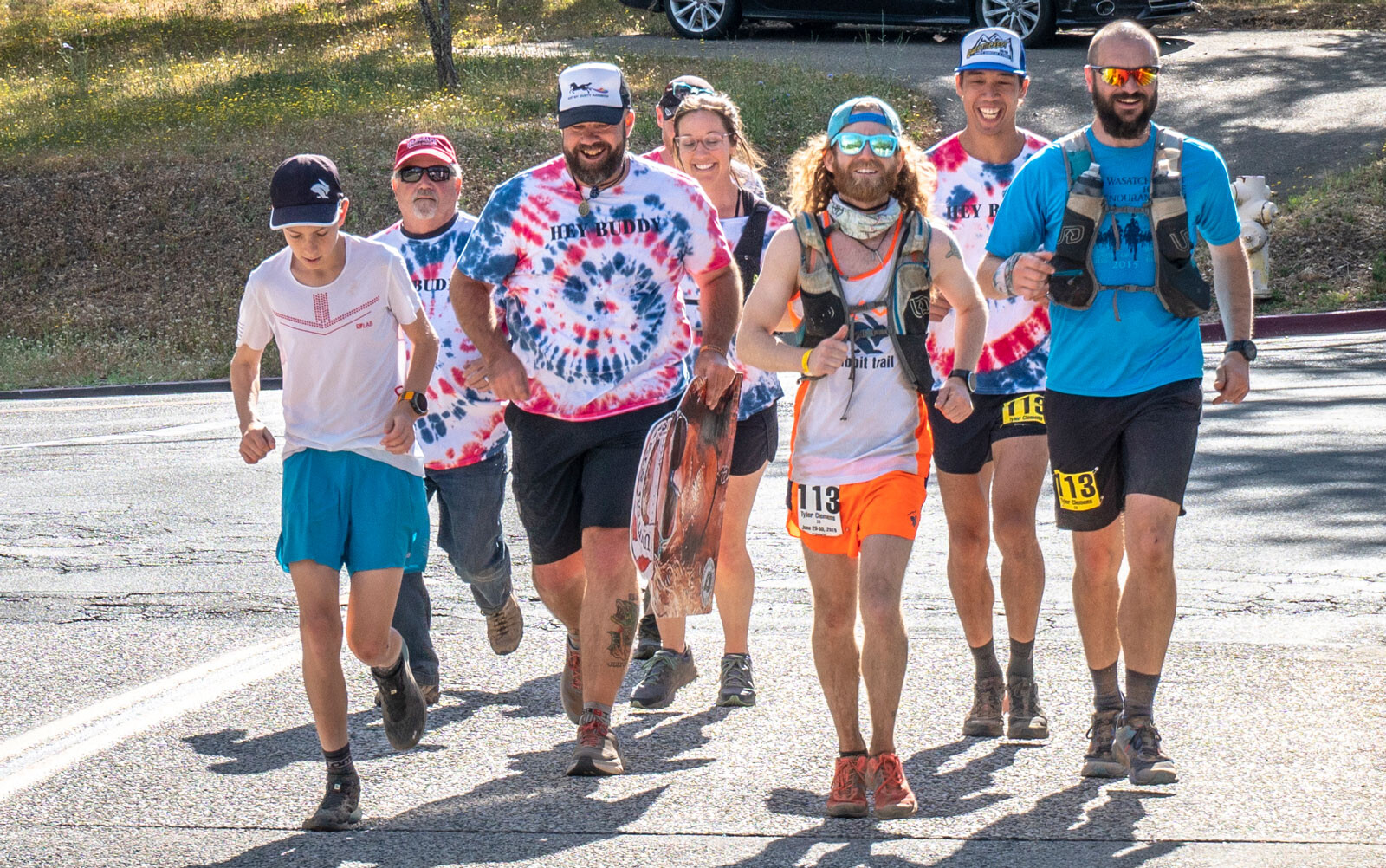
Some 16 miles of the course were burned over by last fall’s Mosquito Fire, leaving miles of shade-less terrain. And of course, there will probably be weather at play, with the event’s notorious heat likely to encompass the middle and lower elevations of the course.
The men’s race at last year’s Western States 100 was sharp, with just 50 minutes separating the first and 10th finishers. Seven of that stellar line-up are back this year, as well as some serious additions like the U.K.’s Tom Evans, French-Canadian Mathieu Blanchard, and Dakota Jones.
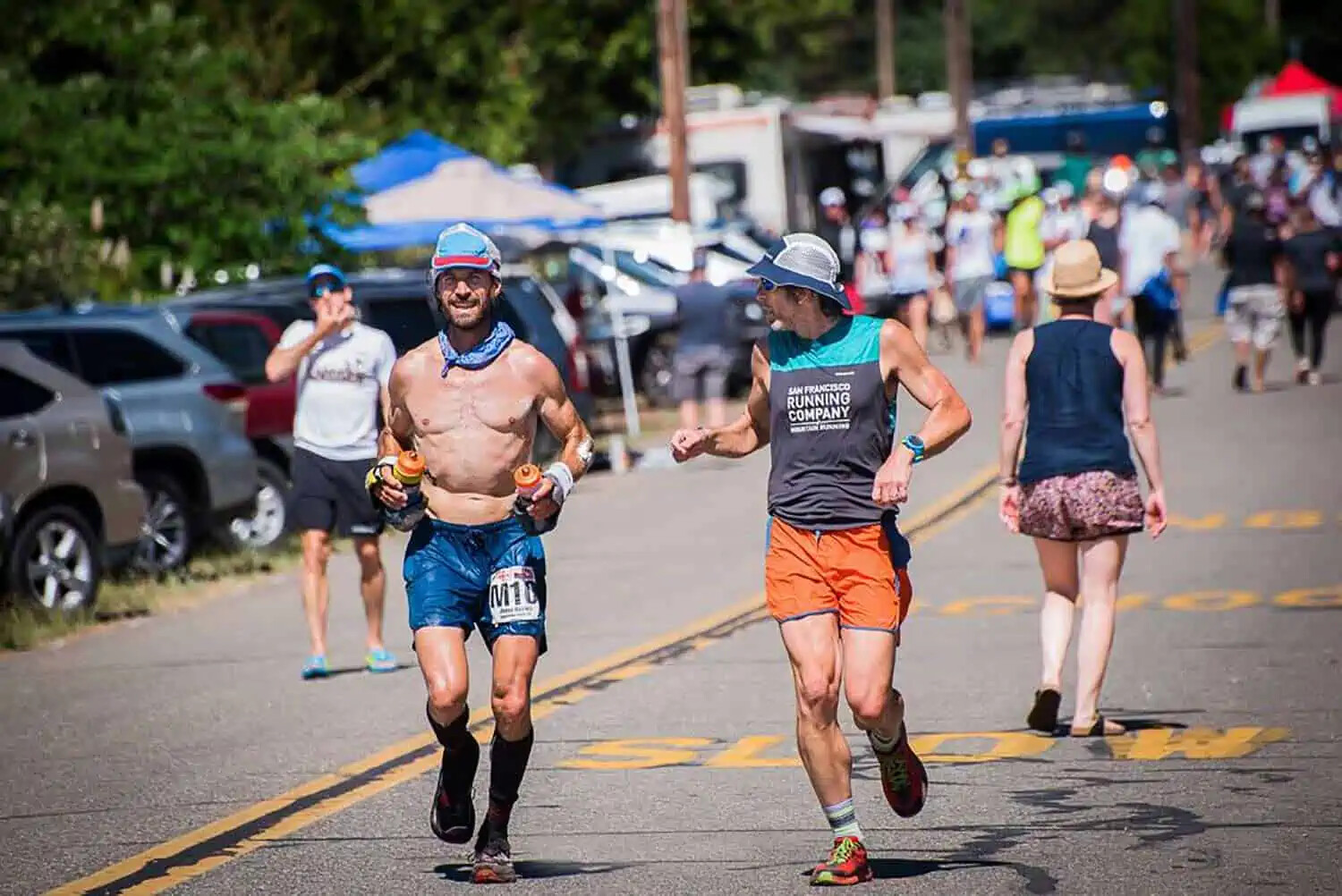
Although there are notable absentees including reigning champion Adam Peterman and course-record holder Jim Walmsley, the depth of this men’s field suggests it could be an even tighter race this year.
As you’d guess, iRunFar will be there to report firsthand on all the action as it unfolds starting at 5 a.m. U.S. PDT on Saturday, June 24. Stay tuned!
A special thanks to HOKA for making our coverage of the Western States 100 possible!
Be sure to check out our in-depth women’s preview to learn about the women’s race and, then, follow our live coverage on race day!
The top 10 runners in the 2022 race were invited to return for 2023. Unfortunately, reigning champion Adam Peterman is out with injury, and seventh-place Vincent Viet of France has opted not to return. It also looks like fifth-place Drew Holmen has withdrawn, as he just finished fifth at the Trail World Championships 80k, held in Austria 15 days before Western States.
Hayden Hawks – 2nd, 15:47:27
Last year’s second-place man, Hayden Hawks, was pretty jovial in his post-race interview about not being able to best race winner Adam Peterman. But without the reigning champion present on the start line, this could be Hawks’s year. Despite struggling with the heat last year, his finish time knocked two hours off his eighth-place finish from 2021, and there are lots of indicators that he could have more to offer on this course.
Some of his previous top performances include a 5:18 win at the 2020 JFK 50 Mile and a win at the 2018 Lavaredo Ultra Trail. So far this year, he’s warmed up by winning the Canyons 50k and taking second at the Tarawera Ultramarathon 100k.
Arlen Glick – 3rd, 15:56:17
Arlen Glick surpassed a lot of people’s expectations when he took third at Western States last year. Although he went into the race with bag of form in the 100-mile distance — having won the Javelina 100 Mile, the Mohican 100 Mile and the Burning River 100 Mile all in 2021 — this was his initiation into mountainous ultrarunning. He took to it very well, running a stormer to place third, and has since logged more mountain miles, taking second in the Run Rabbit Run 100 Mile later in 2022, before returning to the 2022 Javelina 100 Mile to place third.
Tyler Green – 4th, 15:57:10
Tyler Green took fourth at Western States last year, and forced third-place Arlen Glick into an uncomfortable sprint finish as he closed on him in the race’s final moments. In terms of placing, he was back from his second-place finish in 2021, but improved his finish time by about 14 minutes in his third go at the race. In 2019, he placed 14th in a time of 16:51, in what was a very fast year.
Following on from Western States last summer, he had a below par run at the 2022 UTMB, making it just inside the top 50, but showed he is back on form with a third-place finish at the 2023 Transgrancanaria. Last year in his pre-race interview he spoke about stepping back from his day job of teaching to focus more on track coaching and his own running, so that may have allowed him to come into this year’s race with better preparation than previous years.
Ludovic Pommeret (France)
Ludovic Pommeret, sixth at last year’s Western States, went on to inspire veteran racers everywhere with a commanding win at the 2022 TDS at age 47 — almost an hour clear of second place on the demanding route. Some of his other top performances include a win at the 2016 UTMB, where he also took fourth in 2021, and a win at the 2021 Diagonale des Fous.
He’s probably at the other end of the spectrum of Arlen Glick, in that his best performances have been on courses more mountainous than this one, but he’s still not to be underestimated.
Not many ultra-trail runners have made Kilian Jornet sweat to the degree that French-Canadian Mathieu Blanchard did at last year’s UTMB. The two battled it out all day for a close finish, in which Blanchard took second place — under the existing course record — thus earning his Golden Ticket into Western States. He’s been mixing it up a lot this year, taking second in the 146-mile Coastal Challenge Expedition Run stage race in Costa Rica, third in the Marathon des Sables, and running 2:22 in what looked like a fairly casual effort at the Paris Marathon.
by Sarah Brady
Login to leave a comment
Western States 100
The Western States ® 100-Mile Endurance Run is the world’s oldest and most prestigious 100-mile trail race. Starting in Squaw Valley, California near the site of the 1960 Winter Olympics and ending 100.2 miles later in Auburn, California, Western States, in the decades since its inception in 1974, has come to represent one of the ultimate endurance tests in the...
more...Course records fall at chilly Black Canyon 100K in Arizona
Temperatures were cooler than usual at Saturday’s Black Canyon 100K near Phoenix, Ariz., a Golden Ticket race for Western States Endurance Run. The race started just a degree or two above freezing, and gradually got warmer as the day wore on, resulting in some record-breaking finish times.
Anthony Costales of Salt Lake City, Utah, took the overall win in a new course record of 7:32:50 (20 minutes faster than Sage Canaday’s CR from 2016), improving on his fifth-place finish last year. Keely Henninger of Portland, Ore., won the women’s race in 8:45:30, three minutes ahead of Brittany Petersen’s CR from 2021, and 15th overall.
Tom Evans of the U.K. finished second, five minutes behind Costales, with Germany’s Janosh Kowalczyk third, in 7:40:00. All three were ahead of the previous course record. American pro triathlete Heather Jackson, who is relatively new to the trail running world, took second in the women’s race, in 7:47:59 (also under the previous CR), with Meghan Morgan third, in 8:53:52.
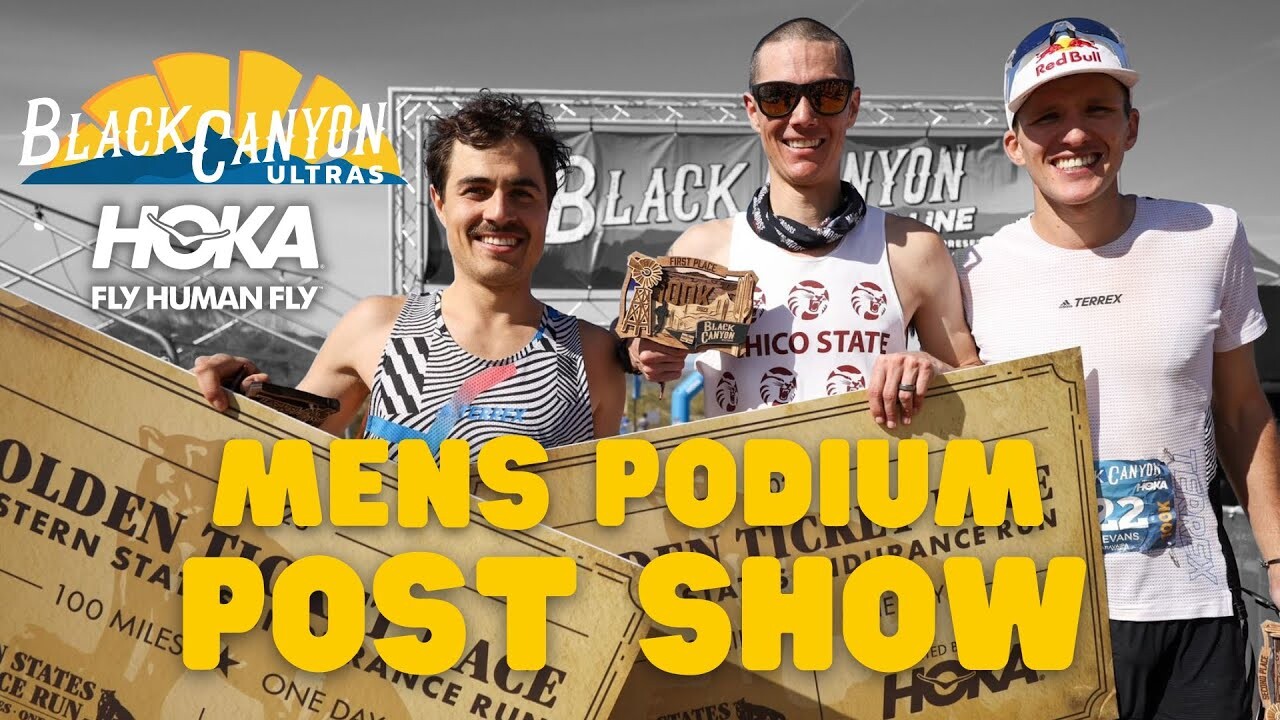
The first and second women and men receive automatic entry to the Western States Endurance Run, to be held June 23 in Olympic Valley, Calif.
Top Canadians

Elliot Cardin of Bromont, Que., was the fastest Canadian in the 100K race, snagging an eighth-place finish in 8:10:22, after finishing 14th in 2022. Mercedes Vince, another relative newcomer to the trail scene, was the top Canadian woman, finishing 14th, in 10:04:20.
The 60K race, which took place Sunday, was won by Joshua Park (4:37:10) and Mimmi Kotka of Sweden (4:55:46, for sixth overall).
by Anne Francis
Login to leave a comment
Black Canyon Ultras
The Black Canyon Ultrasoffer runners an immersive experience along Arizona's historic Black Canyon National Recreation Trail. This event features two point-to-point races: a 100K on Saturday and a 50K on Sunday, both traversing the rugged and scenic Sonoran Desert. The 100K race begins at Mayer High School in Spring Valley and concludes at the Emery Henderson Trailhead near New River....
more...2022 UTMB Men’s Race
As expected, the men took the race out fast from the start on the relatively flat roads and trails from Chamonix to the village of Les Houches. Spain’s Pau Capell, the 2019 UTMB winner, led a charging group through Les Houches, seven kilometers into the race, followed closely by Mathieu Blanchard, a Frenchman living in Canada, and Jia-Ju Zhao and Guo-Min Deng, both of China. All the top contenders were in a massive chase pack, settling in for the long night and day ahead.
It didn’t take long for Jim Walmsley (pre-race interview) of the USA to make his intentions for this year’s race clear, coming into Saint-Gervais, at 20 kilometers into the race, in the lead, looking strong and relaxed. Kilian Jornet and Capell were just seconds behind with Deng, Zhao, and American Zach Miller making up a chase group half a minute in arrears. They were followed by Frenchman Germain Grangier, Blanchard, Frenchman Thibaut Garrivier, and Yan-Qiao Yun of China.
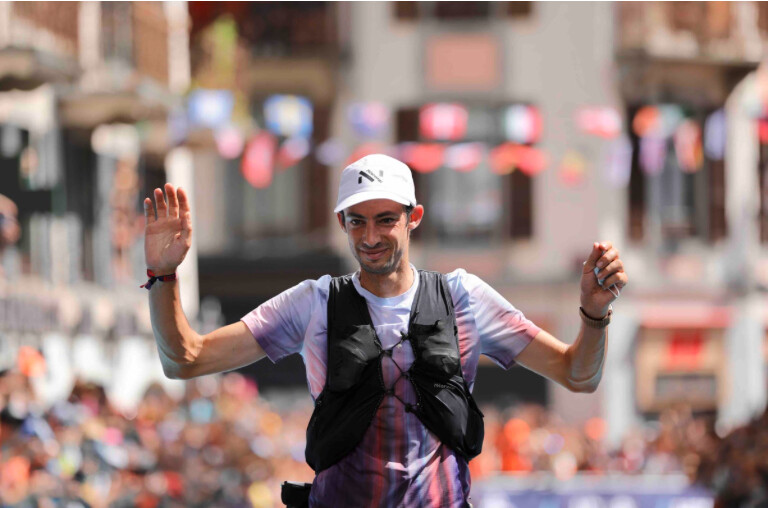
Unsurprisingly, by Les Contamines, 31 kilometers into the race, it was shaping up to be a showdown between Walmsley and Jornet. They came into the aid station together looking relaxed, Walmsley taking the time to high-five fans, and were shortly on their way into the night together. Capell and Miller came in just 30 seconds back, and Grangier rounded out the top five, just a minute behind them.
A notable withdrawal around this time due to physical issues is last year’s second place finisher, Frenchman Aurélien Dunand-Pallaz (pre-race interview).
Climbing over the high Col du Bonhomme, 43 kilometers in, Walmsley, Miller, Jornet, and Tom Evans (pre-race interview) of the U.K. shared the lead. With 1,160 meters (3,800 feet) of climbing down just on this one climb, everyone in the group looked relaxed and was moving well. Capell was just 90 seconds back, trying not to let the elastic to the front group snap in the dark of the night on the run over to Col du Bonhomme before the long descent into the remote French outpost of Les Chapieux.

The four leaders stayed together down to Les Chapieux, 50 kilometers into the race, where last year’s winner, François D’Haene — not participating this year — was spectating and cheering on runners. Unfortunately, Capell had lost contact with the lead group over the previous section, coming into the aid station more than two minutes back. The rest of the top nine stayed relatively the same with Erik Sorenson of the USA slotting in 10th for the first time.Coming into Lac Combal, 66 kilometers into the race, after crossing country borders into Italy and traversing the most remote part of the course, Walmsley and Jornet had only slightly pulled away, their gap to Miller and Evans hung at a tenuous minute. All four looked strong, but it seemed like pre-race predictions of a two-man showdown were about to be realized.
Walmsley, with his arms and legs fully covered from the cold of the night but shirt front open, came into the town of Courmayeur, 80 kilometers in, solo and in the lead, but his gap on Jornet just 80 seconds.
Both men were moving well and left the aid station together after only a few minutes. It was a significant 12 minutes before Evans and Miller came through, staying in Courmayeur for under three minutes. Blanchard, looking more relaxed than any of the previous four, was also in and out of the aid station quickly, 18 minutes off the lead. Known for his slower starts and late race surges, Blanchard appeared to know exactly what he was doing.
It was never a question of if Walmsley or Jornet would strike out on their own, it was just a matter of when. Walmsley was the first to throw down a serious acceleration, coming into Arnouvaz (97 kilometers) solo and with a 2.5-minute gap on Jornet. Both were in and out of the aid station quickly, looking strong and motivated. Blanchard also chose the trail between Courmayeur and Arnouvaz to make his move, coming into the Arnouvaz aid station in third, looking very controlled and 14 minutes behind the leaders.
He was familiar with that position in the race, having finished third in UTMB in 2021. He was also familiar with the race tactic of starting slower, letting the leaders fight it out early and tire themselves out, and then moving up as the fast starters dropped back. It had brought him success the previous year, and he was seemingly employing the strategy again. Miller and Evans continued to run near each other, what Evans would later refer to as a “bromance” that lasted over half the race, and both looked like they had less spring in their step than the men ahead of them.
Committed to making the move stick, Walmsley climbed the Grand Col Ferret at 102 kilometers with a strong powerhike and held a five-minute gap over Jornet. Seemingly unconcerned with his position, Jornet chatted in French with both spectators and volunteers before vanishing into the night. Moving faster and looking stronger over the col than the previous two men, Blanchard continued the chase in third 17 minutes back. Miller and Evans continued to work together to keep the gap manageable.
The gap between Walmsley and Jornet stretched even further to 14 minutes by the sleepy Swiss village of La Fouly, 112 kilometers into the race. Both men were running under course-record pace, and both looked calm and collected. Still running strong into La Fouly, Blanchard kept the leaders within reach.
But Walmsley was committed to stretching the elastic on the field as much as he could, coming through Champex-Lac at 125 kilometers with 13 hours and 40 minutes on the race clock, gaining even more time on the course record and moving strongly. It’s generally a bad idea to bet against Walmsley after he’s put his mind to something, and after a fifth place finish in 2017 and DNF in 2018 and 2021 at UTMB, his commitment to the race and move to Europe to train on the trails seemed to be paying off.
But Walmsley is also known for going out fast and strong, and it doesn’t always stick.One could argue that Jornet was just biding his time, letting Walmsley burn his matches out front. However, there were times around this point in the race where Jornet just plain looked like he was working, enough so that we all began to wonder if the GOAT of trail running would have a crack in his armor today. However, by Trient at 142 kilometers, Jornet had decided to make his move, coming into the aid station in the lead. But instead of seeing Walmsley behind him, it was a surging Blanchard, less than a minute back that Jornet would have to now battle.
It was a long 19 minutes before Walmsley would arrive, appearing to be in discomfort. The dynamic duo of Evans and Miller continued to run together, still holding the gap to the race leader at just over 30 minutes, as they had for much of the race.As the kilometers ticked down, it was indeed a showdown between two men, except it was Blanchard challenging Jornet, with both men coming into Vallorcine at 153 kilometers together, well ahead of the course-record pace.
With Walmsley slowly losing time to the leaders but still in third, eyes moved to Evans who’d finally dropped Miller after nearly a night and a day of racing side by side to see if he could make the pass.By this time, it felt nearly inevitable that Jornet would run to the win and it was no surprise when he came into Tete aux Vents solo looking focused and fast with an 11-kilometer downhill run to the finish. Blanchard never gave up the chase, seven minutes back, while Evans passed a tired but “pumped” Walmsley to slot into third for the first time.
Jornet would finish with a course-record time of 19:49:30, besting both François D’Haene’s 2014 record time (20:11:44) on a course which did not include the Pyramides Calcaires, a gnarly little climb and descent added to the UTMB course a few years back, and Capell’s 2019 time (20:19:09), which did include those extra kilometers.
This is his fourth win at UTMB. Just five minutes back, Blanchard would also come into the finishing chute under the previous course record in second place. An elated Evans rounded out the podium, a stellar finish for his first UTMB.
Walmsley came across the line in fourth, releasing the two DNF monkeys on his back and finishing the next step in his goal of ultimately winning this race someday. Miller, no longer on the comeback trail following surgery and recovery, but fully back, crossed the line in fifth place.
Most of the back half of the men’s top 10 are runners who started slower and bided their time, moving up in the race’s second half, including France’s Beñat Marmissolle, France’s Arthur Joyeux-Bouillon,Jonas Russi of Switzerland, and Romania’s Robert Hajnal. The final member of the men’s top 10, however, is France’s Thibaut Garrivier, who went out hot and looked like he paid for it later, but ultimately holding onto 10th place.
Login to leave a comment
North Face Ultra Trail du Tour du Mont-Blanc
Mountain race, with numerous passages in high altitude (>2500m), in difficult weather conditions (night, wind, cold, rain or snow), that needs a very good training, adapted equipment and a real capacity of personal autonomy. It is 6:00pm and we are more or less 2300 people sharing the same dream carefully prepared over many months. Despite the incredible difficulty, we feel...
more...HOW ULTRARUNNER TOM EVANS ESCAPES HIS COMFORT ZONE
The ultrarunner started his sporting career for a bet, and discovered a love of pushing his limits that has kept him moving ever since.
“My thought process can best be described as ‘minimal’,” laughs Tom Evans, describing his 2017 entry into the six-day, 251km Marathon des Sables, held annually in the Sahara Desert. As well as being possibly the toughest race on the planet, it also happened to be Evans’ first. “I knew it was the hardest race out there, and I thought there was no point in doing the easy ones,” he says. “I’d jump straight in at the deep end.”
Though he lacked any formal training, Evans’ self-belief carried him to an unbelievable third place – the fastest time run by any European in the race’s history – and, naturally, skyrocketed him into the world of professional ultrarunning. “I was always sporty,” explains the 29-year-old. “I represented England at rugby, hockey and athletics events while at school. Looking back, I wasn’t necessarily the best, but I always tried the hardest. After school, I realised I didn’t want to go to university, so at 18 I joined the army. I’d always felt I had something to prove, and in the army an easy way to do that was by keeping fit. The army is an endurance-based organisation, which suited me really well.”
After the Marathon des Sables, Evans capped off a successful streak by winning the 101km CCC race at the 2018 Ultra-Trail du Mont-Blanc. The following year, he left the army to pursue running full-time, and he hasn’t looked back. Next on his schedule is Red Bull’s official charity partner event the Wings for Life World Run on May 9 – a unique race with no finish line, in which runners compete against a ‘catcher car’ until it overtakes them. This year’s participants will still compete at the same time, but – due to COVID-19 restrictions – they’ll run against a virtual car, via an app.

It’ll be different from Evans’ past experiences at the annual event, but he’s a master of adaptability. Currently holed up in Loughborough with his fiancée, professional triathlete Sophie Coldwell, he’s keeping busy by switching snowy trails for road running and has even smashed the Three Peaks challenge on a treadmill. Here’s how Evans keeps pushing forward...
The Red Bulletin: You came third in the Marathon des Sables after entering for a bet. How?
Tom Evans: My friends did [the race] in 2016 and finished in the top 300. I thought I could do better, and over a few beers they bet me I couldn’t. I signed up the next morning. There’s a lot of crossover with the military, because you’re sleeping outside under the stars and pushing yourself to your limits every day. Through running the race, I discovered this ability to suffer for a very long time in the heat. Two years later, I left the army to become a full-time professional athlete.
Ultrarunning is one of the most punishing sports. Is it all down to this natural ability?
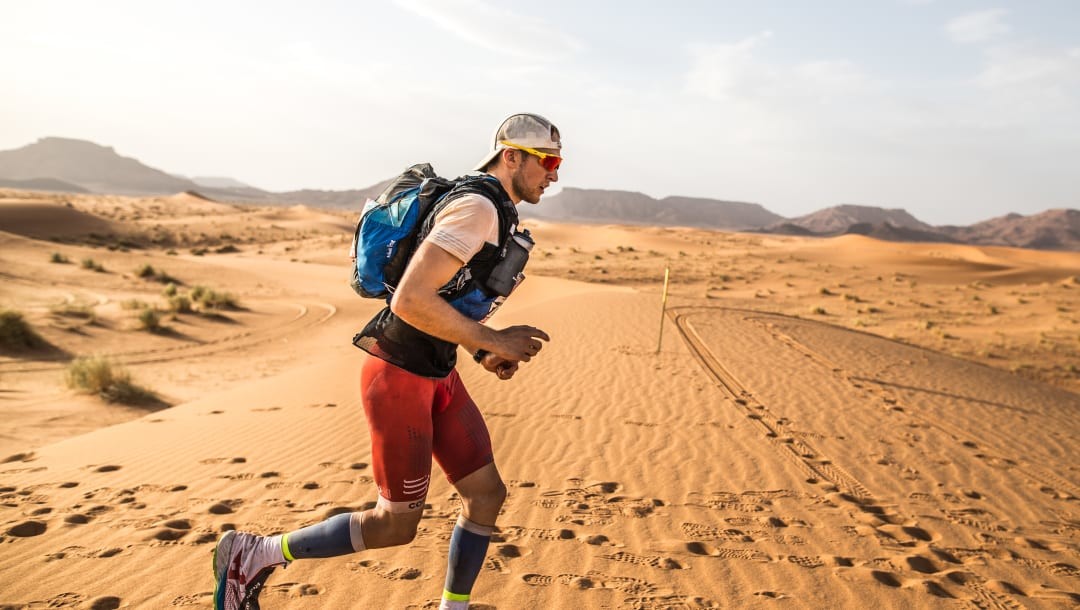
No, I train very hard and I get used to suffering. I know in any race there will come a point when I’ll want to stop. When I get there it’s like, ‘Right, I knew it was going to happen, so now’s the time to embrace it, but also know that the minute after you stop, it’s going to stop hurting.’ I think I can withstand a lot, but I want to know how long I can actually keep feeling uncomfortable for.
Many people struggled to find focus during lockdown. What kept you motivated?
It’s very easy to keep a habit once you have it, but it’s very difficult to start the habit in the first place. I think people go from never running at all to loving it. Then there’s the other side of that: as soon as you do stop something like running, it’s very difficult to start again. So, for me, it’s about keeping as much consistency as possible. I always set mid-term and long-term goals – I’m very goals-based. Having gone from boarding school to the military, I like knowing what I’m doing.
Typically I drive to the Peak District or Snowdon or the Lake District, where there are phenomenal trails, but I wasn’t able to do that in lockdown. So I started running from my door instead. Road running suits me well, because it’s easier to collect data on your run. You don’t have to pigeonhole yourself into a certain distance or event. I run because I love running, and it’s a brilliant thing to be able to do.
What’s your plan for the Wings for Life World Run?
Because it’s a charity event, my goal is to raise as much awareness for spinal cord research as I possibly can by putting in a performance that people talk about. It’s going to be a long, uncomfortable run, which is my sweet spot. I think the best way people can physically prepare is to go on the website and play around with speeds; look at how far you can get [while] running at a certain pace. Because it’s on the app, you can challenge your friends virtually, which keeps the competition alive.
Login to leave a comment
Ultrarunner Tom Evans prepares for his biggest race at Olympic marathon trials
Like many, ultrarunner Tom Evans has struggled with the lack of races in lockdown. The former army captain burst onto the ultrarunning scene in 2017, coming third in the six-day Marathon des Sables, and last year he set a new record in the Tarawera 102km Ultra Marathon, in New Zealand. But he has had to adapt to circumstances and is now setting his sights on the marathon in the rescheduled Tokyo Olympics.
We talked to the 29-year-old about swapping the trails for the pavements, his mental strength, the Olympic marathon trials and his role as a Garmin ambassador.
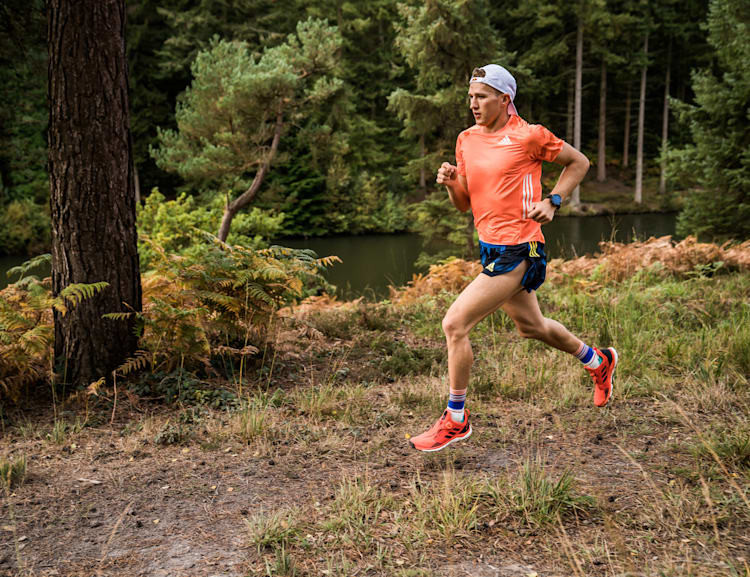
You’ve set your sights on the Tokyo Games. How did this happen?
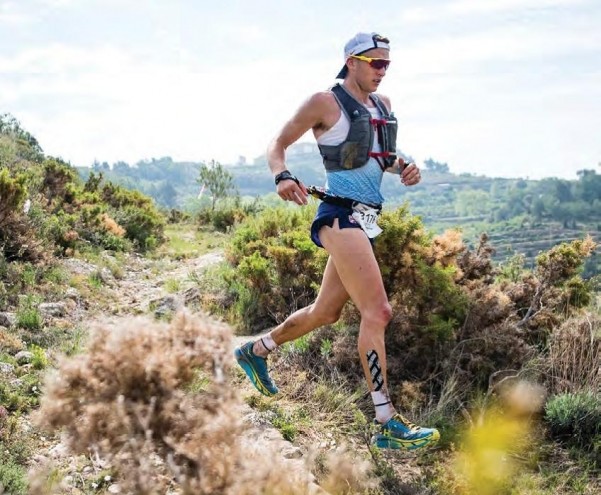
‘At the beginning of the pandemic, Tokyo was not on my list whatsoever – I very much planned on staying on the trails and running long rather than running fast. I guess what the pandemic has taught me is that I like structure and I’m a very goal-orientated athlete and person. I have to have goals, whether it’s “Today I’m going to list 10 things on eBay” or something bigger; I have to set goals and achieve those goals. It’s the same with my running, with there being so little opportunity to race, I thought I need something to set my sights on and if something is going to happen, it’s going to be the Olympics.
‘[With the lockdown restrictions] we couldn’t drive to run or go on training camps, which is how I would normally do my trail running and my ultrarunning. It’s all been very much running from the door, so I’ve been running a lot more on the road, which has led to running a bit quicker and that’s opened my eyes to what I could run at the marathon trials at the end of next month.’ [The event will take place on a looped course in Kew Gardens, London, on Friday, March 26.]
How do you feel about the trials?
‘I’m really excited – for me, it’s really unknown. I think I’ll be able to take a lot of lessons I’ve learnt from ultrarunning into the race and I’m really looking forward to the challenge. It’s been great fun training for it and to now get the opportunity to push myself to the limits and see what I’m capable of.’
‘You know that during a marathon you’re going to hurt and you know that when it starts to hurt, the training that you have done before is what’s setting you up to keep doing it. I go into a race saying, “I know this is going to hurt” and when it starts hurting I think, “Bring it on; I’ve done the training, I trust myself and I knew this was going to happen and now it’s happening, it’s no surprise.”’
by Jane McGuire
Login to leave a comment
Tokyo 2020 Olympic Games
Fifty-six years after having organized the Olympic Games, the Japanese capital will be hosting a Summer edition for the second time, originally scheduled from July 24 to August 9, 2020, the games were postponed due to coronavirus outbreak, the postponed Tokyo Olympics will be held from July 23 to August 8 in 2021, according to the International Olympic Committee decision. ...
more...Callum Hawkins, Charlotte Purdue and Stephanie Davis withdraw from World half Marathon Championships
Ahead of next week’s World Half Marathon Championships in Gdynia, Poland, British Athletics can confirm that Callum Hawkins (coach: Robert Hawkins; club: Kilbarchan), Charlotte Purdue (Nic Bideau; Aldershot, Farnham & District) and Stephanie Davis (Phillip Kissi; Clapham Chasers) have all been forced to withdraw from the British team.
Hawkins, the European half marathon leader, was due to make his first appearance at the Championships since the 2016 World Half in Cardiff, where he claimed an individual 15th position, and earlier in the week, clocked 14:05 over 5k in the Fast 5K at Aston-in-Makerfield.
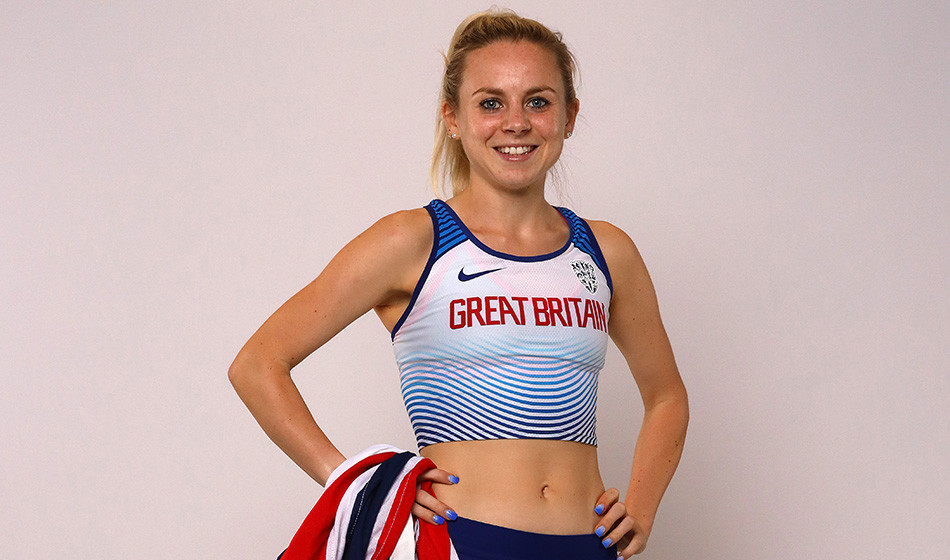
He will be replaced in the team by fellow Scotsman Adam Craig (Steve Vernon; Inverclyde), who will make his British debut on the roads next week. In his maiden half marathon in Antrim last month, the 25-year-old clocked 63:24 to move 13th on the British half marathon list for 2020.
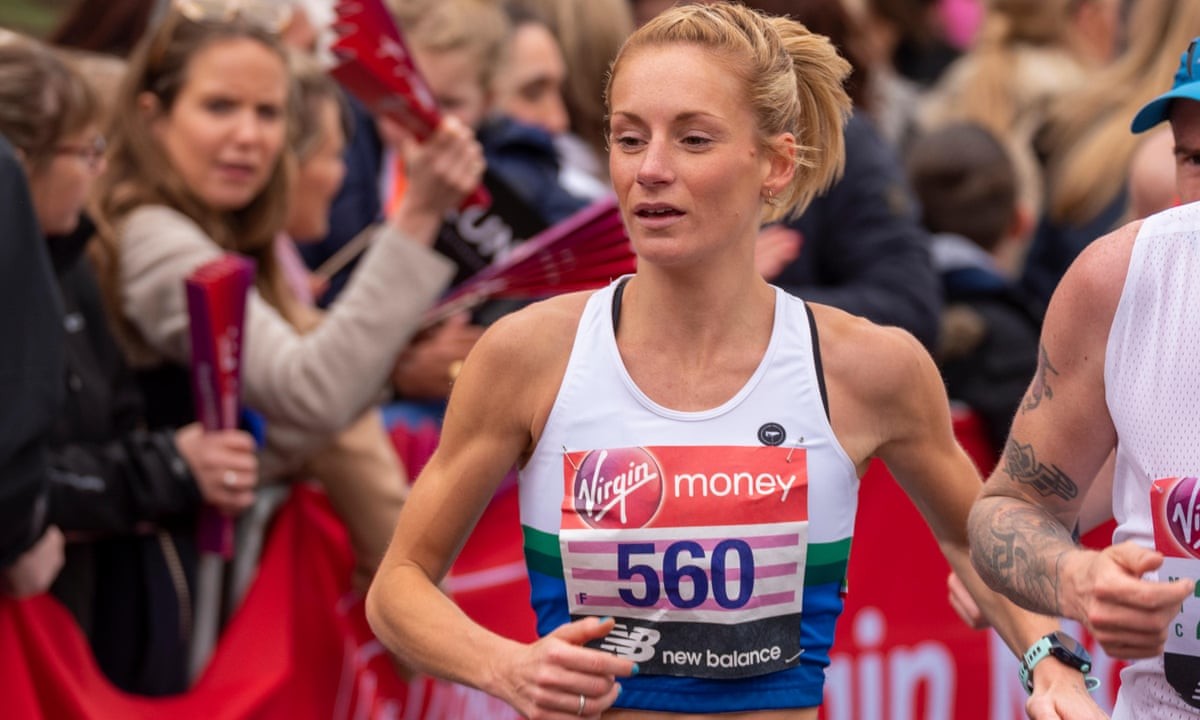
Fellow European half marathon leader Purdue, who led the British team in Valencia’s World Half in 2018, has been forced to withdraw through injury. She clocked a season’s best of 68:23 in Marugame, Japan, back in February and was in line for a third consecutive appearance at the Championship.
Davis, who was due to make her debut at the Championships after a personal best 71:15 at the Big Half in London back in February, has also been forced to withdraw through injury. Neither athlete will be replaced in the team at this late stage.
The British team selected for the World Athletics Half Marathon Championships on October 17:
Men:
Mohamud Aadan (Paul Oppe; Thames Valley), Adam Craig (Steve Vernon; Inverclyde), Tom Evans (Andrew Hobdell; Belgrave), Kristian Jones (Dundee Hawkhill), Jake Smith (James Thie; Cardiff).
Women:
Becky Briggs (Mick Woods; City of Hull), Clara Evans (Chris Jones; Cardiff), Samantha Harrison (Vince Wilson; Notts).
Login to leave a comment
World Half Marathon Championships
The Chinese city of Yangzhou will host the 2022 World Athletics Half Marathon Championships. China, one of the fastest-growing markets in road running, had 24 World Athletics Label road races in 2019, more than any other country. It hosted the World Half Marathon Championships in 2010 in Nanning and will stage the World Athletics Indoor Championships in Nanjing in 2021. ...
more...Callum Hawkins and Charlotte Purdue will lead British squad for World Athletics Half Marathon Championships Gdynia 2020
Callum Hawkins and Charlotte Purdue will head the British squad for the World Athletics Half Marathon Championships Gdynia 2020 on October 17.
Hawkins, the the fourth place finisher in the marathon at last year's World Championships, clocked 1:00:01 at the Marugame Half Marathon in February, the fastest by a European this year. He'll be making his first appearance at the World Athletics Half Marathon Championships since 2016 when he finished 15th.
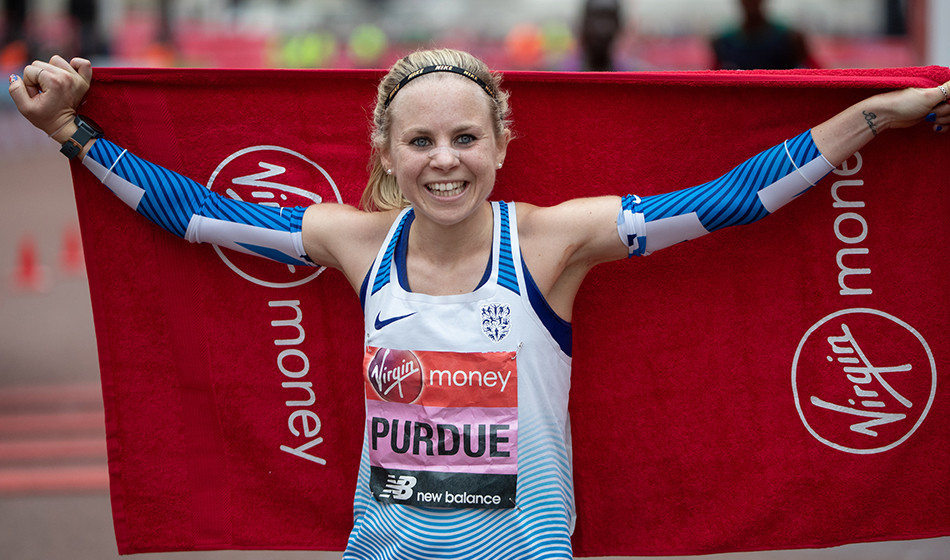
Hawkins joins British U23 half marathon record-holder Jake Smith, who was third in 1:02:00 at the Vitality Big Half, and Mohamud Aadan, who finished 36th at the 2018 World Half Marathon Championships.
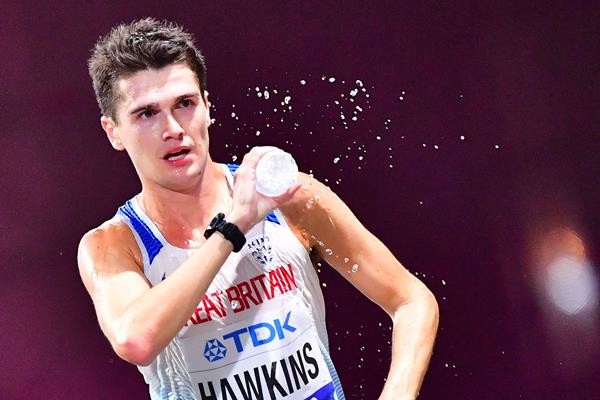
Like Hawkins, Purdue clocked her European lead of 1:08:23 in Marugame, finishing second. Purdue will be making her third World Half Marathon Championships appearance after finishing 33rd in 2016 and 21st in 2018.
Purdue is joined by Charlotte Arter, a teammate from 2018, who finished fifth at the Barcelona Half Marathon in February in a season’s best 1:10:00. She too will be making a third consecutive appearance at these championships.
Samantha Harrison and Stephanie Davis, who notched personal bests of 1:11:01 and 1:11:15 when finishing second and third place at the Big Half, join Hayley Carruthers in being handed British debuts in Poland.
Kristian Jones, who clocked a personal best of 1:03:09 at February’s Barcelona Half Marathon, and world trail bronze medallist Tom Evans, who lowered his PB to 1:03:15 in Antrim earlier this month, will also make their British debuts on the roads to round out the men's team.
"I am delighted that we are able to name such a strong team for the rescheduled World Athletics Half Marathon Championships in Gdynia, Poland, next month," said team leader Robert Hawkins.
"The team has been revised following athlete withdrawals from the original team named for March’s championship, but I feel we have been able to add a good blend of international experience to those that are making their first appearances on the roads for Great Britain & Northern Ireland."
British team for Gdynia
Men: Mohamud Aadan, Tom Evans, Callum Hawkins, Kristian Jones, Jake Smith
Women: Charlotte Arter, Hayley Carruthers, Stephanie Davis, Samantha Harrison, Charlotte Purdue
by World Athletics
Login to leave a comment
Mo Farah and Lily Partridge were the winners at Antrim Coast Half Marathon
Mo Farah takes first as Marc Scott, Ben Connor, Stephen Scullion and M60 Tommy Hughes impress, while Lily Partridge enjoys women’s win
Mo Farah was first across the line in the Antrim Coast Half Marathon on Saturday (Sept 12) in 60:31 but the most eye-catching performances came from those following in his slipstream.
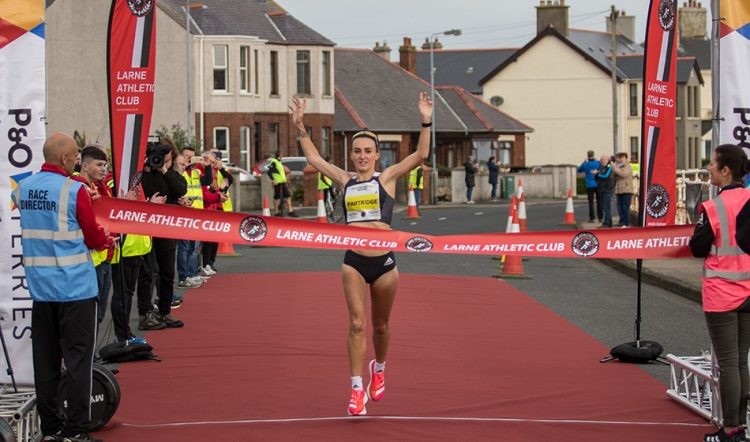
Runner-up Marc Scott was close behind with 60:43 on his debut at the distance to go No.3 on the UK all-time rankings. In third, London Marathon-bound Ben Connor took 16 seconds off his PB with 60:59 to go equal fourth with Steve Jones in fourth on the UK all-time lists.
Stephen Scullion, in fourth, smashed the Northern Ireland record by a big margin with 61:12. Like Connor, the Belfast man is set to run the London Marathon on October 4 too as the popular local athlete took more than two minutes off his best.
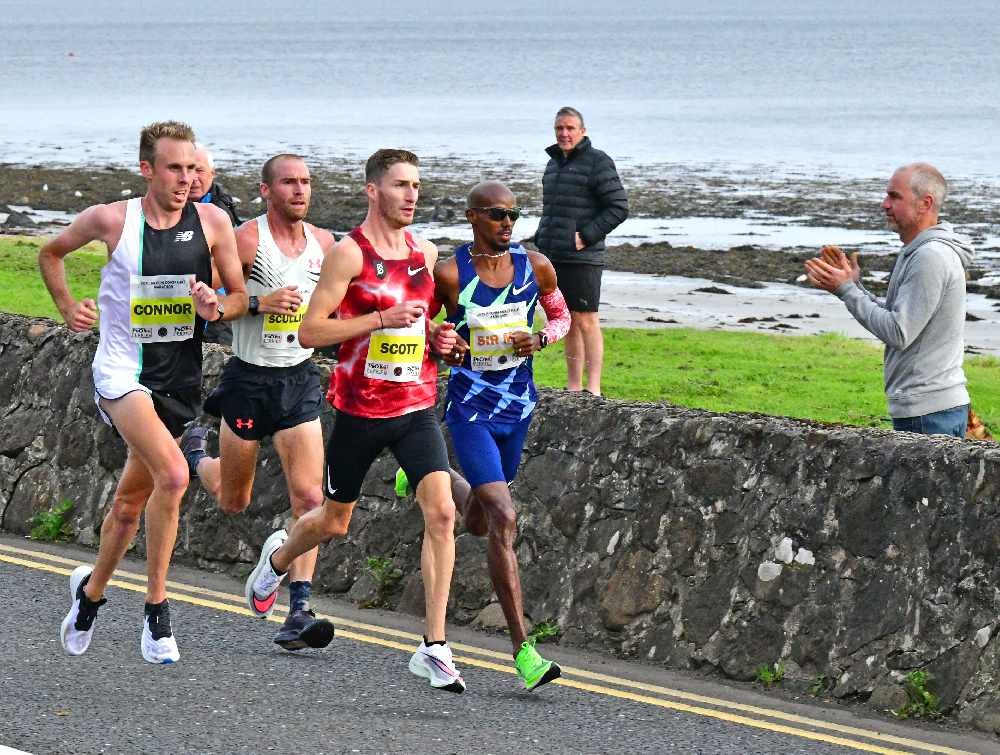
Lily Partridge, another London Marathon-bound Olympic hope, impressed as well as she broke away from Sam Harrison to win the women’s race in a Northern Ireland all-comers’ record of 71:36 – around a minute outside her PB but 23 seconds ahead of Harrison (71:58) as Clara Evans was third 72:21 and Becky Briggs, in fourth, ran a UK under-20 record of 72:54.
Perhaps most impressive of all, though, was masters sensation Tommy Hughes, who broke Martin Rees’ world half-marathon record for an M60 with 71:09 (even quicker than the 71:26 originally publicised shortly after he finished).
An Olympian in the marathon back in 1992, the Irish runner Hughes has been on a record-breaking spree recently and continued his great form here.
Ordinarily Farah and others might have been racing in the 40th Great North Run this weekend but with the event cancelled due to coronavirus he came to Northern Ireland instead to run in an event organised by his old friend and fellow athlete from his student days, James McIlroy.
McIlroy put together a fine domestic field for the event and Farah certainly did not have it all his own way as he only broke away from the in-form Scott in the final mile.
Scott has broken the UK 5km road record this summer and took the British 5000m title last week. He was leading in the closing stages but had no answer to Farah’s breakaway surge in the final mile.
A lead quartet of Farah, Scott, Connor and Scullion broke away early and ran together for much of the distance. Behind, Kevin Seaward was fifth in 63:09 followed by Josh Griffiths (63:12), Tom Evans (63:19), Adam Craig (63:28) and Adam Hickey (64:37).
There had been talk of Farah potentially attacking his UK record of 59:32 from Lisbon in 2015 but during media interviews on Friday he said winning the race was the main goal and he did not want to underestimate his rivals and treat it as a time trial.
Runners in this elite-only event, which was sponsored by P&O Ferries, enjoyed decent weather on a picturesque course that proved a great advertisement for athletics in Northern Ireland. The only frustration for fans was the poor quality of the live stream, which made following the race difficult after organisers had, ironically, encouraged spectators to stay at home instead of supporting from the side of the road.
by Jason Henderson
Login to leave a comment
How high-tempo training with elite Ethiopians helped Briton Tom Evans to place third at the Western States 100 this year
Tom Evans spent two months in Ethiopia training with elite marathon runners to prepare for this year’s Western States 100 mile ultra marathon. The training paid dividends as he finished third with the fastest ever time by a non-American runner of 14 hours, 59 minutes and 44 seconds.
“The slowest runner [in the Ethiopian running group], except for me, was a 2:08 marathoner,” the Briton said. “That made it very interesting. Their tempo runs were on dirt tracks with rolling hills, so were perfect for Western States.”
“They would run until they dropped and we were being followed by a car so they’d be picked up,” Evans said. “At first, because of the altitude, I was the first to drop out but I began to get used to the elevation.”
WSER100 is one of the most prestigious 100 mile races in the world. It takes place in California, starting at altitude before descending into deep, hot canyons. Jim Walmsley won this year’s race in a record 14:09:28.
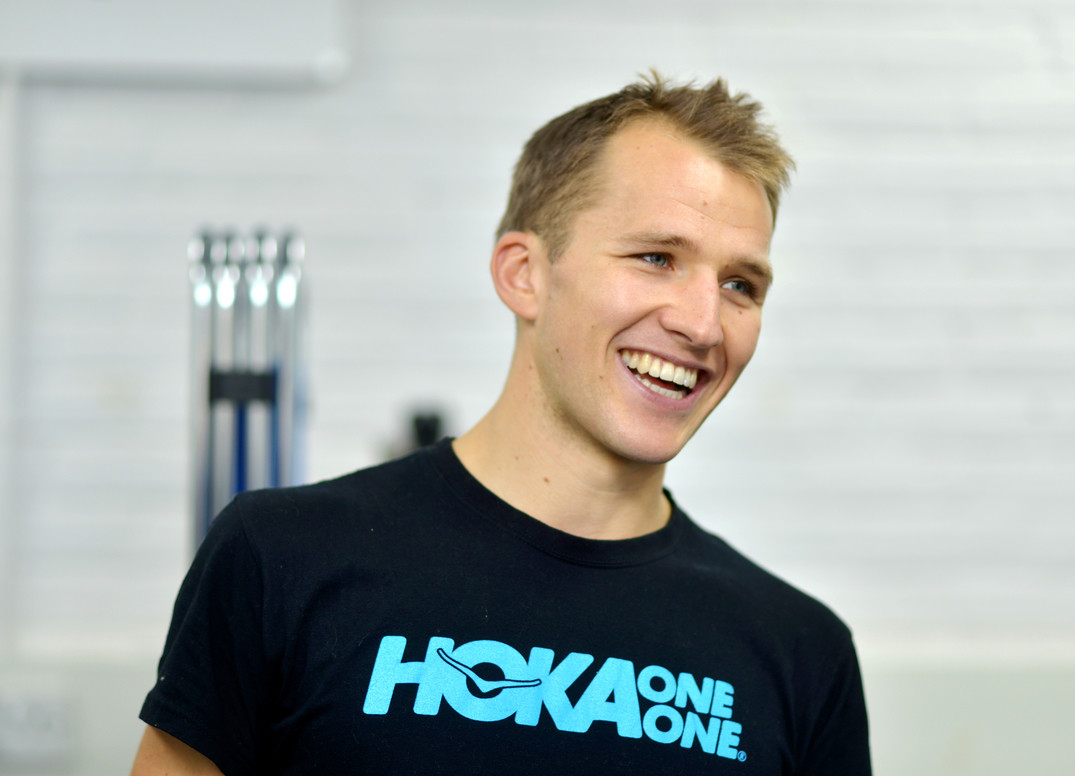
The brutal tempo sessions in Ethiopia were fuelled by fierce rivalries, with runners motivated by the hope of being picked up by foreign agents and given the opportunity to race and earn money abroad.
“It’s almost becomes survival of the fittest,” Evans said.
The “sag wagon” that accompanied the runners was always a tempting respite from the sessions.
“You can drop out when ever you want,” he said. “So, it’s about how much you want it. It was really good mental strength training as they were always going fast and furious.”
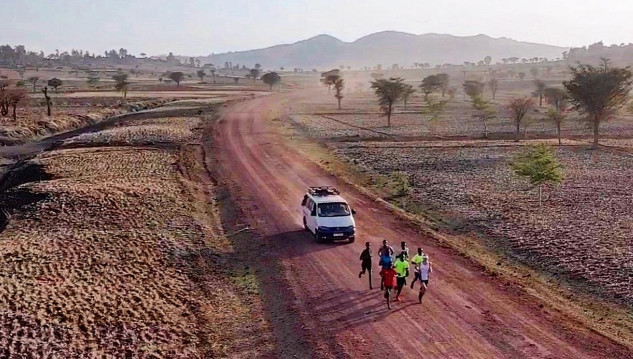
Being in a new environment forced the former soldier to be more flexible in his attitude to training.
“You had no idea what was going to happen. I had kids throw rocks at me one day,” he said. “It was such a culture shock. I just had to deal with what was ahead of me day by day.”
Evans said he had learned from them the importance of strong contrasts between hard and easy sessions.
He felt not all of the training was relevant to his competition goals. The other athletes in the group were all preparing for marathons or half marathons, so their longest run was just two hours. Evans would sometimes head out for eight hours at a time.
“They thought I was absolutely mental,” he said. “They couldn’t get over how much volume I was doing. But they were fascinated. They really respected what I was doing.”
There were no coaches on hand to force runners on to the track or trail, but the total immersion experience meant they were not necessary.
“I became so attuned to my body. I was making decisions to drop out of sessions all based on feel,” he said.
Evans, who has won the CCC event at the Ultra Marathon du Mont Blanc (UTMB) week, could feel the effects of his training when he ran WSER100.
“I just felt so much more efficient,” he said. “So, at the end, I was still able to run hard.”
“For me, coming third in my first 100 miler was a best-case scenario,” Evans said. “I knew it was possible, I just didn’t know if it was probable.”
For now, Evans is going back to shorter races of about 50km to 100km, but he said the experience had “lit a fire” in him.
“I definitely want to come back and see if I can improve my place, if not my time.”
by Mark Agnew
Login to leave a comment
Western States 100
The Western States ® 100-Mile Endurance Run is the world’s oldest and most prestigious 100-mile trail race. Starting in Squaw Valley, California near the site of the 1960 Winter Olympics and ending 100.2 miles later in Auburn, California, Western States, in the decades since its inception in 1974, has come to represent one of the ultimate endurance tests in the...
more...Britain’s UTMB CCC winner Tom Evans will make his Western States 100 debut next June
Login to leave a comment







